本文由 合造社 授权mooool发表,欢迎转发,禁止以mooool编辑版本转载。
Thanks CLAB for authorizing the publication of the project on mooool, Text description provided by CLAB.
合造社:建筑/艺术创新实验室是合造社设置在成都邛崃的乡建工作室,由建筑师、艺术家、大学科研机构、和乡村工匠共同建造并运营的空间。它之所以被命名为“创新实验室”是因为它将至少从三个维度传递“实验性”的精神:建造方式的实验,乡村建设的实验,以及社会关系的创新实验。
CLAB:The INNOVATIVE LAB of ARCHITECTURE & ART is CLAB’s new studio in Qionglai, Chengdu City, and it is a space built and operated by architects, artists, scientific research institute and rural craftsmen. Its name reveals three, at least, experimental “spirit”: the experiment of construction, the experiment of rural reform movement, and the innovation experiment of social relations.

建筑/艺术创新实验室 INNOVATIVE LAB of ARCHITECTURE & ART
使用传统的材料来建造一个现代的实验空间。夯土作为结构体承托了轻质型钢的屋架。传统材料得以进入现代审美和现代生活,兼容现代化的声光电暖等设备。
Traditional materials were used to build a modern experimental space. Rammed earth supports lightweight steel roof trusses as a structure. Traditional materials can enter modern aesthetics and modern life, compatible with modern sound and photoelectric heating and other equipment.
▽项目的初衷 Original intention of the project
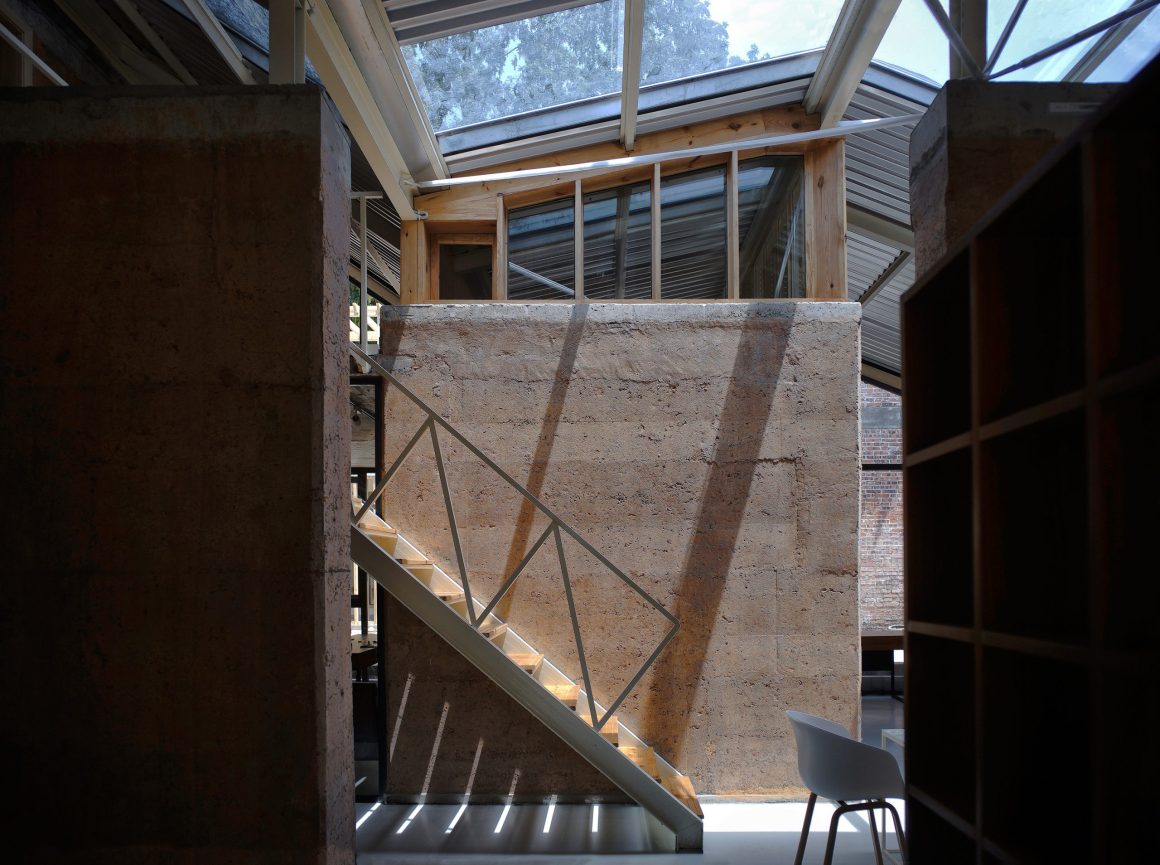
来自土地的纪念碑 MONUMENTS FROM EARTH
历史主义甚嚣尘上,它危言耸听地断言建筑已经无法成为改造社会的手段;但是我认为,建筑需要社会关系作为自我更新的素材。 诚然,建筑的专业性只有在它的传统中才能找到,但是, 建筑不能仅仅为简单反映自身问题和挖掘自身传统而存在。
——维托里奥·戈里高蒂
Historicism is rampant, and it alarmingly asserts that architecture can no longer be a means of transforming society; but I think that architecture needs social relations as the material of self-renewal. Admittedly, the professionalism of architecture can only be found in its tradition, but architecture cannot simply reflect its own problems and excavate its own tradition.
——Vittorio Gregotti
▽在遗址公园中,夯土墙仿佛是来自土地的纪念碑。Rammed earth wall in construction, like a monument that grew out of the earth

▽乡土施工队正在为为夯土墙搭建钢架。Workers in the local construction team are building rammed earth walls

这个空间由传统材料夯土建造,香港中文大学的科研团队为这个项目的夯土建造提供了成熟的技术支持,大幅提升了传统夯土的技术极限,使得它可以在地震八度设防区使用,可以作为建筑的结构体系(而不是维护体系)来使用。这将提高乡村地区的居住安全。这一技术坚持夯土的手作化,以便适应乡村的社会劳动方式,被中国广大乡村地区接纳并传播。而整个空间的建造过程也就是现代夯土的本土工匠培养过程。本土工匠将带着这一技术回归乡野,在基于手作的乡村现实中再建田园,为乡村建设这一历史叙事注入现代的含义。在实验室建成以后,这个空间将开启建筑师和艺术家的驻留活动,让当代知识和乡村自然相互滋养,实验一种可能的创新型社会关系。这便是建筑与艺术创新实验室实践的意义。
This space is constructed by traditional material rammed earth. A scientific research team come from Chinese University of Hong Kong provided mature technical support for the rammed earth construction of this project, which significantly improve the technical limit of traditional rammed earth, so that it can be used in the earthquake of eight-degree fortification areas, can be used as structure (not maintenance system). This will also improve the living security in rural areas. This technology insists the handmaking of rammed earth so as to adapt to the way of social work in the countryside and be accepted and spread by the vast rural areas of China. The whole construction process is also a cultivate scheme for modern rammed earth craftsmen. Local artisans will take this technic returning to their homeland, build their home by hands, considering the reality of undeveloped rural society, and bring modern meaning into the historical narrative. Upon completion of the laboratory, we will operate the residence of architects and artists to mutually nurture contemporary knowledge and rural nature, and to experiment with a possible innovative social relationship. This is the significance of the practice of the INNOVATIVE LAB of ARCHITECTURE & ART.
▽夜晚的建筑/艺术创新实验室 INNOVATIVE LAB of ARCHITECTURE & ART

建筑故事: 建造是一次社会介入 PROJECT STORY :Construction is an engagement of social relation
2017 年,我获得了一个机会,在位于成都周边乡村的一个唐宋的遗址公园里给自己的工作 室“合造社”建一个空间。作为建筑师,这是我第一次在乡村真实的建造房子。而我可使用的建造资源是我在周边拉到的一个农民工。这个空间被命名为“建筑 / 艺术创新实验室”。 项目筹备期,计划了几件事情,几件希望去实验的事情。
第一件事情,我打算用夯土来建造这个空间。
第二件事情,一定以夯土做为结构系统而不是维护体系来完成建造。
第三件事是,组织乡村的夯土工人培训。
对以上三件事情的实践,并非处于对夯土的偏好,或者对希望在这个项目中回溯古风;而是起源于我的一个推测的观念:也许,夯土技术能够介入并重塑造乡村的社会关系。 我把这个项目的建造看作是建筑学知识在社会关系中运作的一次实验,一次介入乡村社会的契机。社会介入也许是乡建更为本质的事情,而不只是在乡村建房屋。
第四件事情,这个建筑一定兼容现代设备,所以,除了在结构上采用了可兼容前现代建造方式的夯土,我们还重新设计了整个建筑的热工构造:手工建造结构级断桥幕墙,以及便宜的保温防水集成屋面……
第五件事情,讨厌灯具,那么用一个结构空间的装置来提供照明。
整个建筑也由农民工手工建造完成。
——徐浪
In 2017, I got a chance to build a space for my studio in a Relics Park in the surrounding countryside of Chengdu. As an architect, this is my first time to truly build something in rural area, which means the construction resources I can use are peasant workers who know hardly the modern construction industry. The space was named ” The INNOVATIVE LAB of ARCHITECTURE & ART “. During the preparation period, several things which are worth to do, to experiment, in a Lab were planned. First thing, I plan to use rammed earth to build this space. Secondly, the rammed earth will be constructed as structural system rather than a maintenance system. This is very important. Thirdly, to organize rammers’ training program in the countryside. The practice of the above three does not lie in appreciation of rammed earth, nor aesthetic preference; it originates from a sociological idea that, perhaps, the rammed earth is a tool engaging and reshaping the social relations of rural China. I regard the construction of this project as an experiment that operation of architectural knowledge operating with social relations become possible. Social engagement may be a more essential thing in rural construction, rather than just building houses in the countryside. Fourthly, the building must be compatible with modern equipment, so in addition to the use of rammed earth as structure, a pre-modern constructing method, we have redesigned the thermal constructing system: manual constructed structural grade broken-bridge-curtainwalls, and inexpensive thermal and waterproof integrated roofs… Fifth thing, hate lamps, then use a structure space installation to provide lighting. The whole building was constructed manually all by peasant workers.
——XuLang
▽乡土施工队的工人们正在堆砌夯土墙。Workers in the local construction team are building rammed earth walls.

▽乡土施工队的工人们正在搭建钢架。Workers in the local construction team are building steel frames.
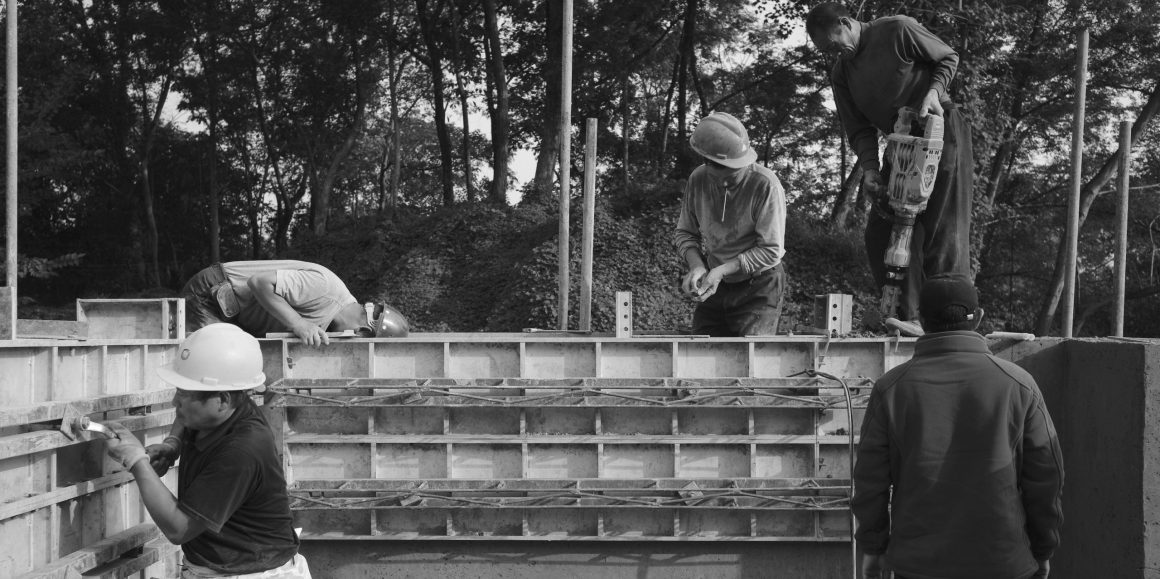
关于设计 : 抗震的框筒平面 A Prototype of “frame-tube + free plane”
手作夯土对于乡村社会的意义不言自明,而建筑学知识能带给乡村社会的无疑是坚固、实用、美观的建筑三原则。安全,在对于缺乏建造监管和现代建筑体系的乡村,尤其重要。
The significance of hand-made rammed earth for rural society is self-evident, and the three principles of architecture, Firmatis (Durability), Utilitas (Utility), Venustatis (Beauty), that architecture knowledge can contribute to rural society are undoubtedly solid, practical and beautiful. Safety is particularly important in rural areas where construction supervision and modern building systems are lacking.
▽平面图 Plan
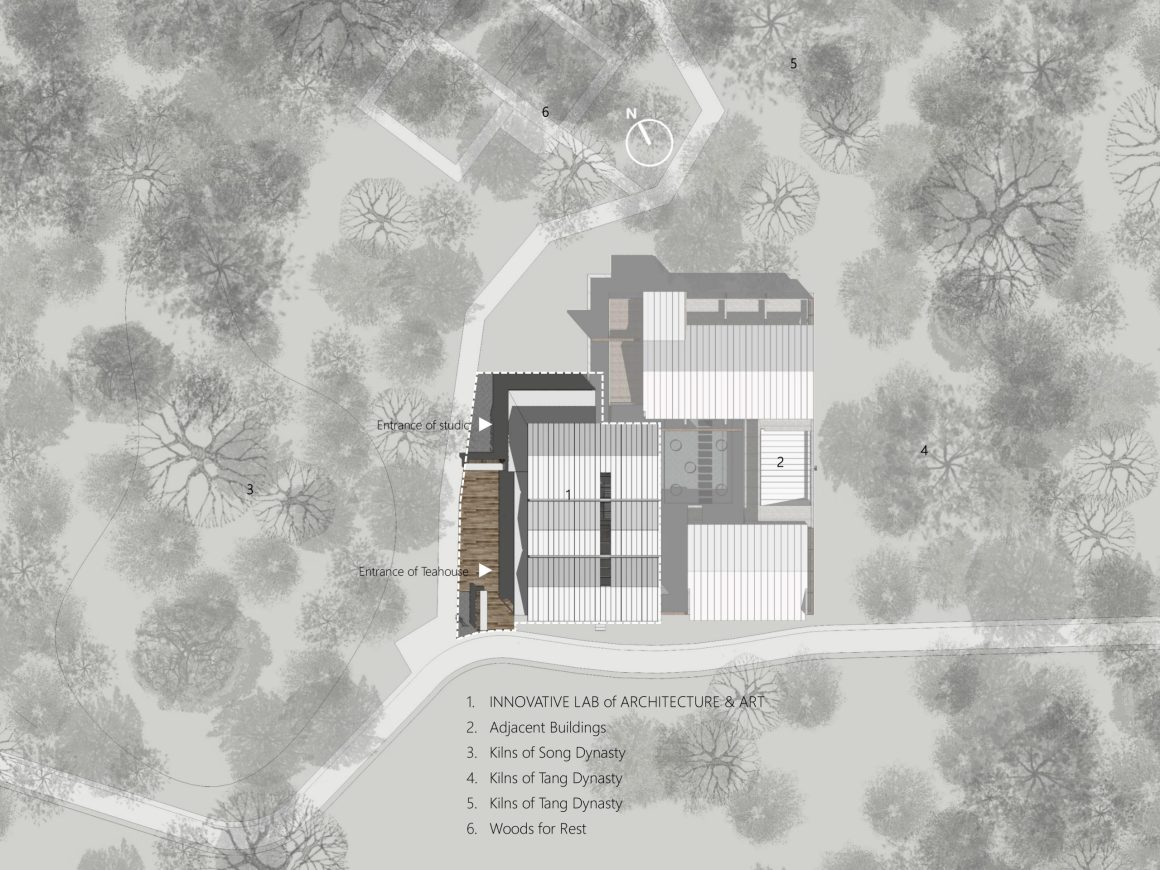
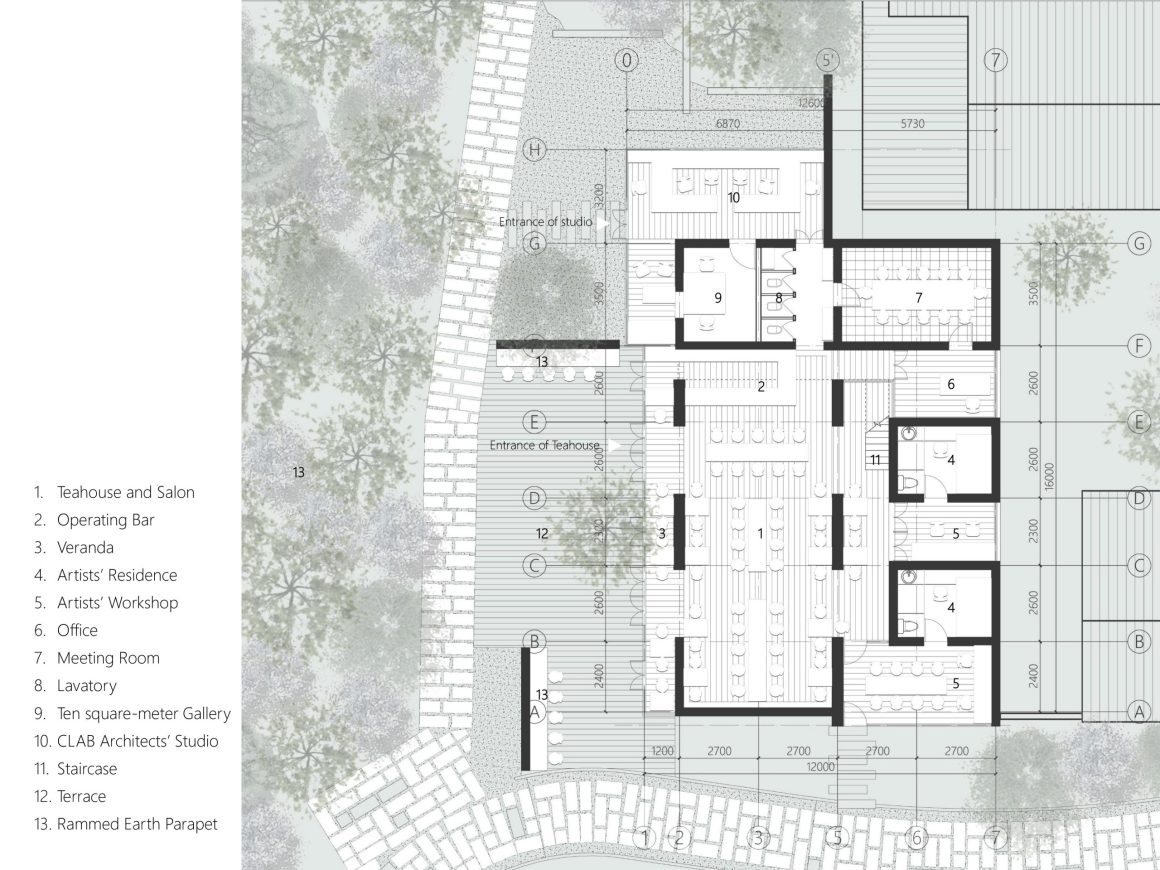
▽剖面图 Profile
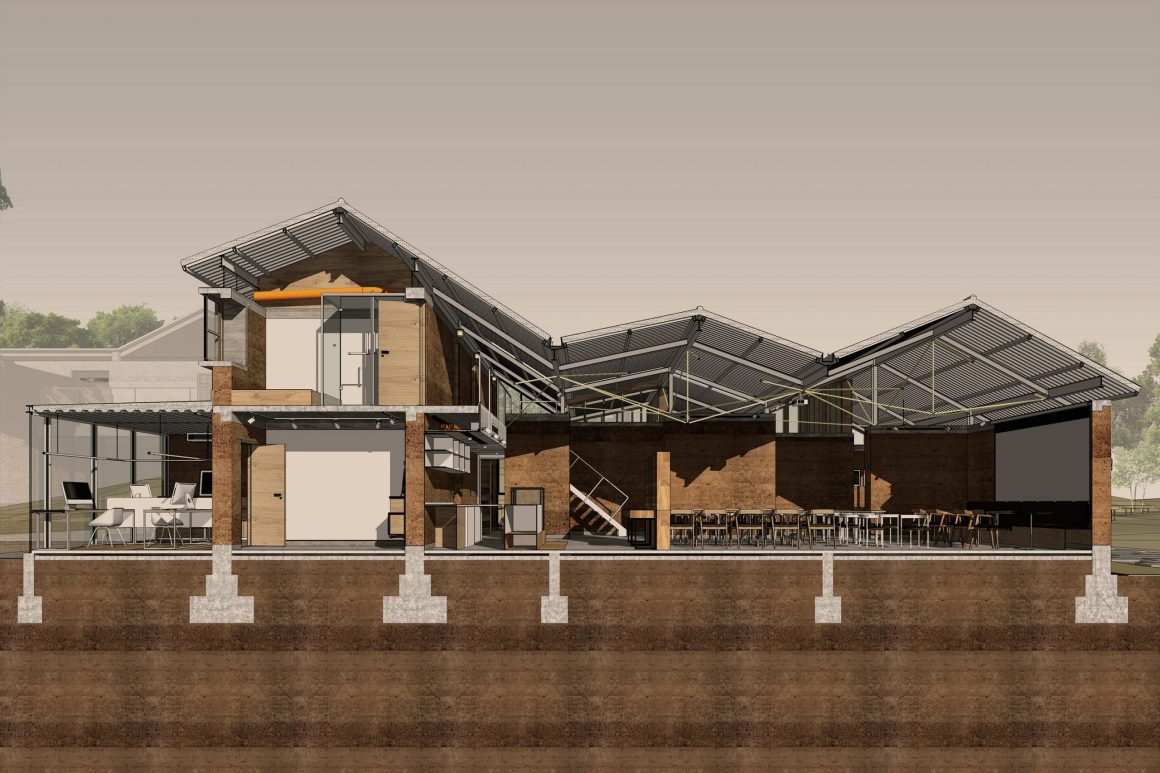
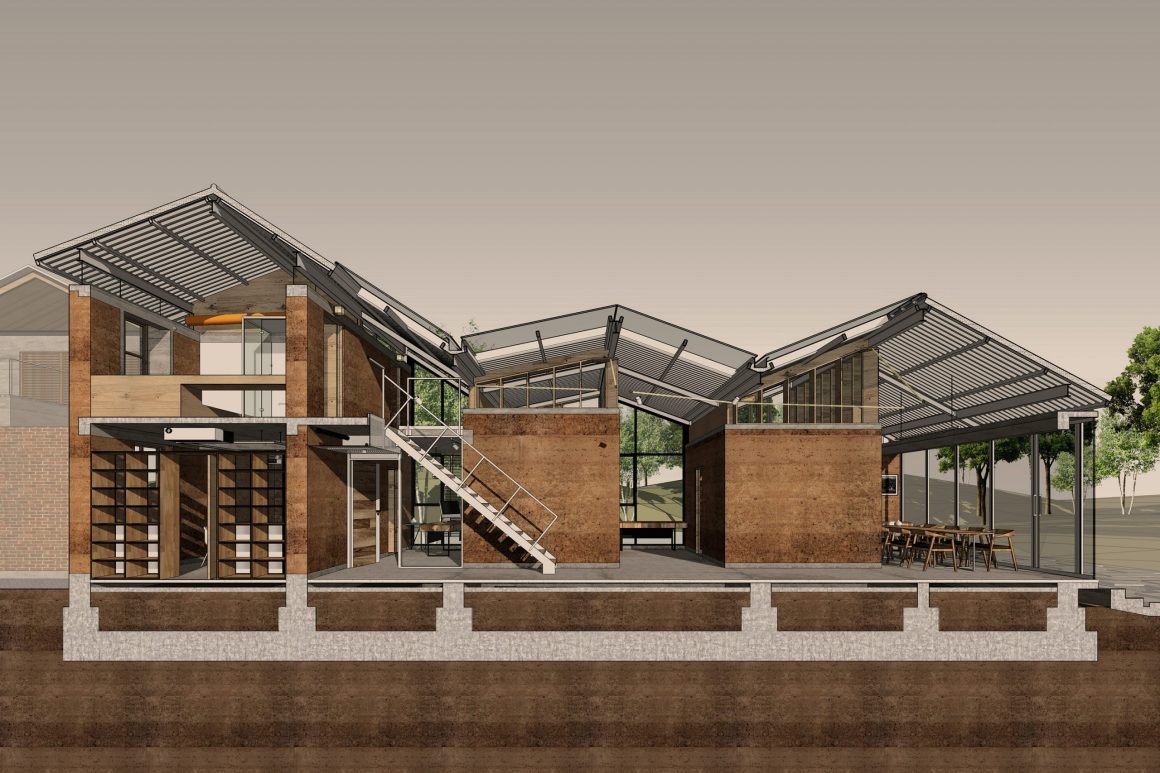
除了材料上的改进,夯土的抗震抗剪性能主要来源于结构平面的合理性。在这个建筑中,大部分的结构构件被设计成为小框筒,抵抗来自任何方向的水平力。而框筒和框筒之间,是作为自由平 面的公共空间。大空间处的片墙,被屋顶钢框架 和基础地梁与抗剪框筒连接在一起。这个平面可以被视作一类结构原型“框筒抗剪 + 自由平面“,适用于大多数的乡村公共空间的建造。
In addition to material improvements, the seismic resistance of rammed earth mainly come from the rationality of structural plane. In this building, most of the structural components are designed as small frames to resist horizontal forces from any direction. And between one frame tube and another, it is a public space as a free plane. The wall in the large space is connected by the roof steel frame and the foundation beam with the shearresistant frame tube. This plane can be regarded as a kind of structural prototype “frame-tube + free plane”, which is suitable for the construction of most rural public spaces
夯土的三个社会接入口 Three Point that Rammed Earth Engages Society
1. 便宜:夯土材料的便宜使得这一技术能在乡村自发推广。
2. 基于手作:手作意味着在一个缺乏现代建造技术 的前现代的中国乡村,建房成为一门生活技能,而不是专业技术。
3. 作为结构:如果夯土不能作为建筑的结构系统,那么这项技术对乡村的社会结构是无效的。 这个项目的建造过程,就是对乡村夯土工匠的培训过程。工匠带着技术,在乡村的熟人社会中建房,并传播这项知识。
1.Cheap: The cheapness of earth materials makes it possible for this technic to be promoted spontaneously in undeveloped rural area.
2. Handwork-based: Handwork means that in the pre-modern rural China lacking modern construction technology, building a house becomes a life skill rather than a professional technology.
3. As a structure: If rammed earth cannot be used as a structural system of buildings, then this technic is ineffective for the rural society. The construction process itself is the training process of craftsmen. Craftsmen bring technology to build houses in rural acquaintance societies and disseminate this knowledge.
▽夯墙根,初代夯土。Rammed wall roots, the first rammed earth.
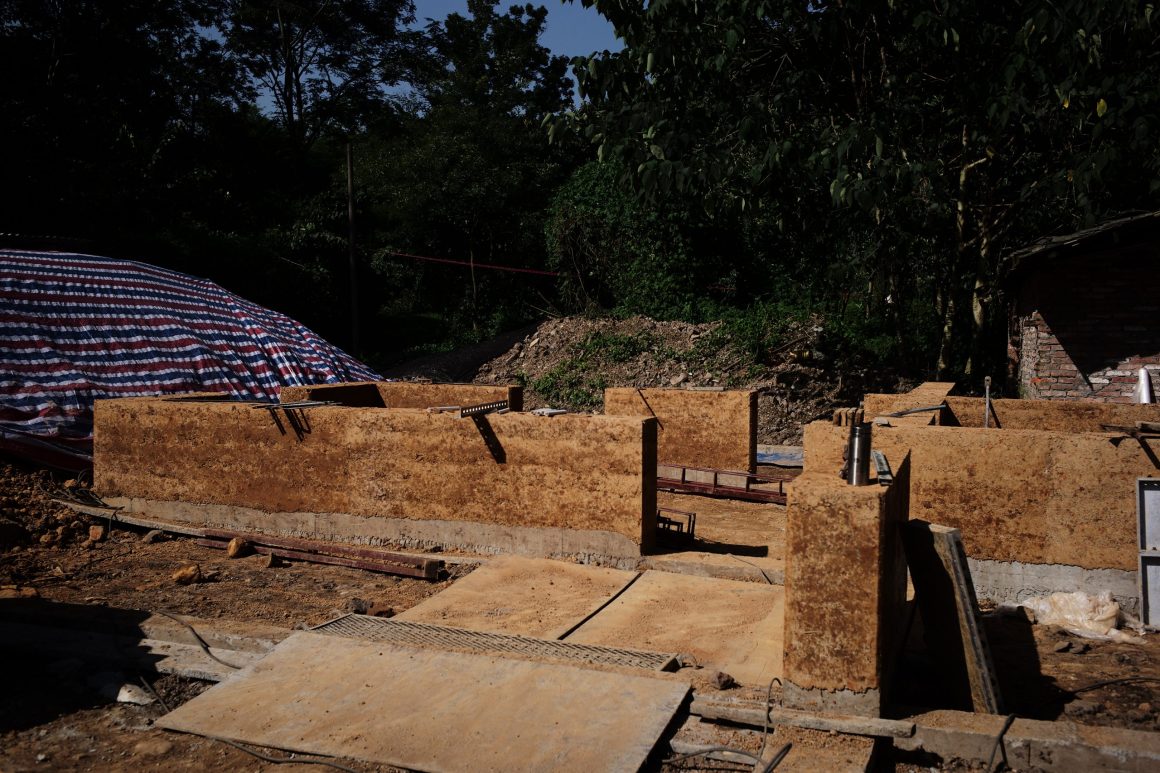
▽建造中的夯土墙 Rammed earth walls under construction.
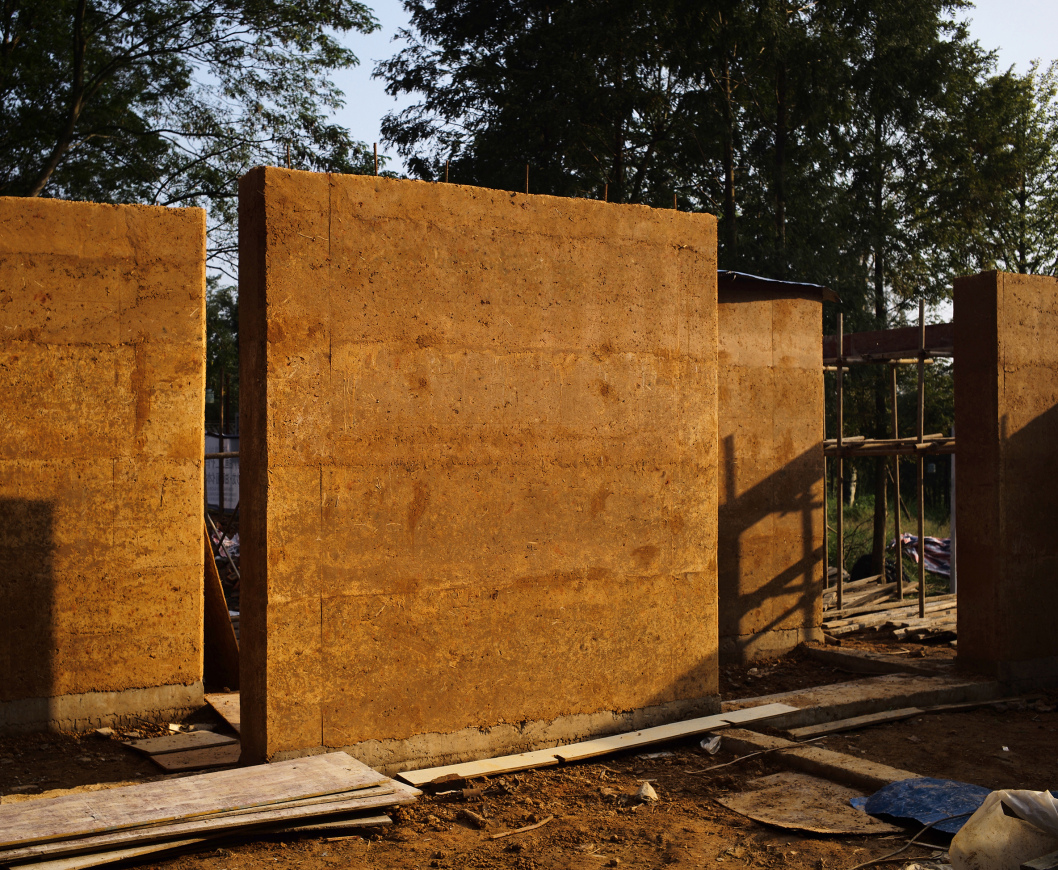
▽乡村施工队的工人在检查夯土墙的密实度。Workers in the village construction team inspect the compaction of the rammed earth wall.
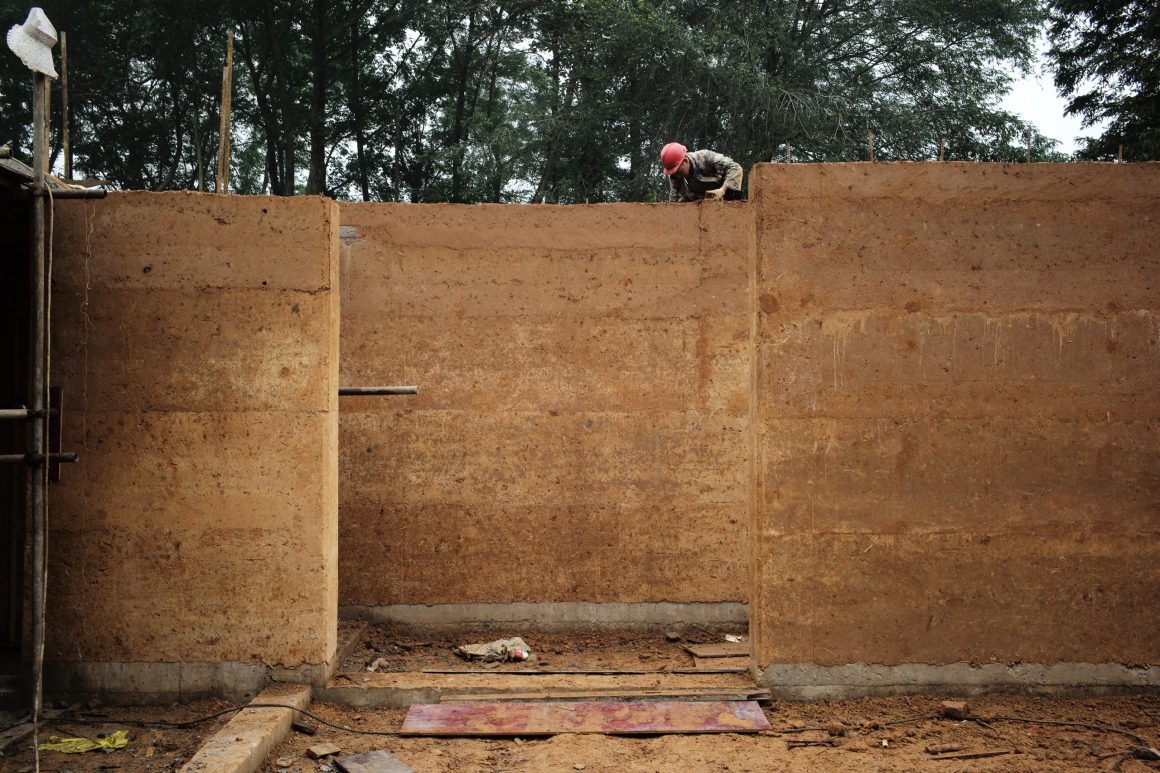
▽夯土墙建造完毕,准备搭建屋架。The rammed earth wall was built and the roof trusses were ready to be erected.
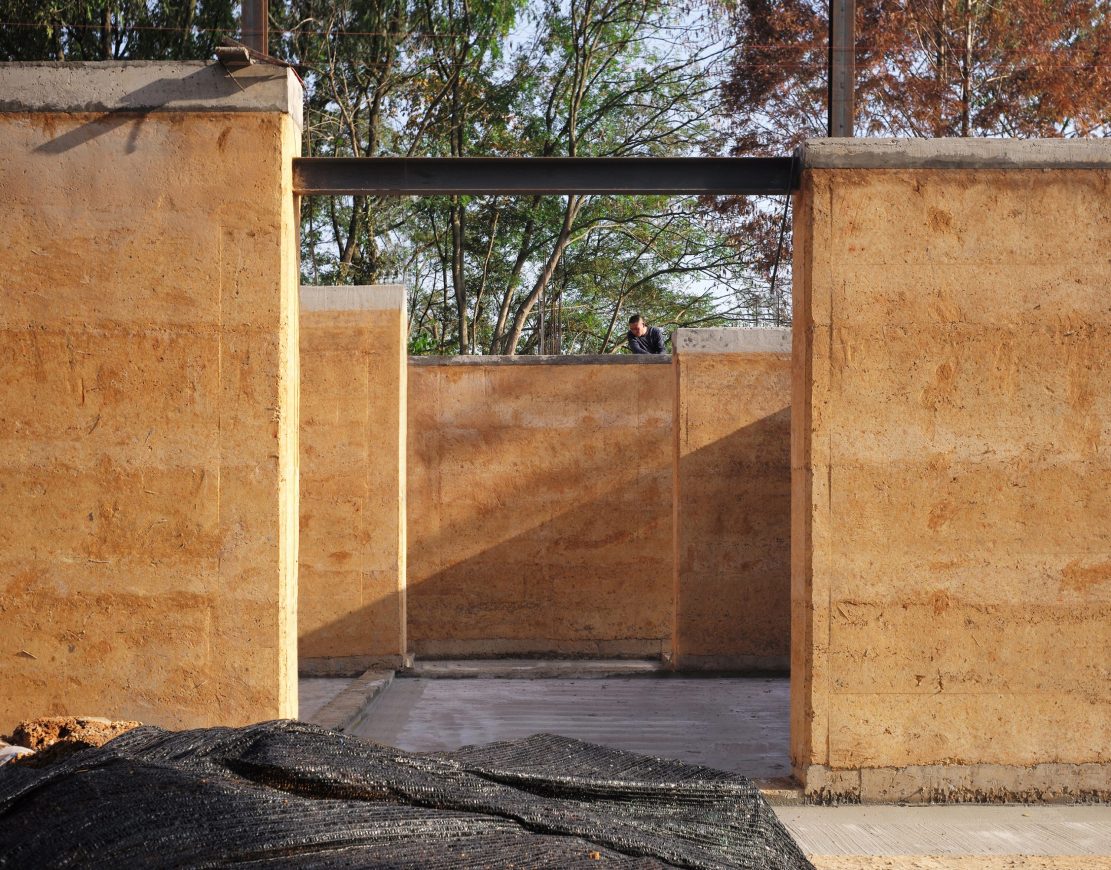
建造过程:如何在乡村给自己建一座房子?THE CONSTRUCTION PROCESS: how to build a house for yourself in the countryside?
大多数参与乡村建设的人都会遇到一个概念叫“改老房子”。但大多数人对改建和重建的分别并不清楚,在改建和重建之间的选择也判断不了。建议如下:
1. 乡村房屋一般为砖木结构,很多房子面临改建时需要替换主柱和主梁。替换主梁意味着屋架要拆除进行替换;替换主柱意味着整个房子地面以上全部要拆除替换。如果不动基础,新柱/梁重建,也是改建的一种方式。如果基础布置也需改动,就是完全重建了。
2. 如果柱梁完好,并且原有建筑的空间适用新的功能,则可以只替换门窗(维护体系),这样的改建可以节省造价。
3. 如果主柱需要替换,房屋必然拆除,建议重新布置房屋平面,以适应新的功能要求。建筑/艺术创新实验室的项目就属于这类情况。原有房屋主柱朽烂,不如连基础一起挖除,更加新功能要求重新设计。
4. 最不建议的方式是,拆除原有结构后,原址原基础原结构重建。旧建筑平面未必适合新功能,而且,这种改建方式的成本比新建建筑更高。
Most people involved in rural construction will encounter a concept called “old house”. But most people don’t know the difference between remodeling and rebuilding, and they can’t judge the choice between remodeling and rebuilding. The recommendations are as follows:
1.Rural houses are generally brick and wood, and many houses need to replace the main columns and main beams when they face renovation. Replacing the main beam means that the roof truss is to be demolished for replacement; Replacing the main column means that the entire house above the ground floor is demolished and replaced. If the foundation is not moved, the new column/beam is reconstructed, which is also a way of reconstruction. If the basic layout also needs to be changed, it is completely rebuilt.
2.If the columns and beams are intact and the space of the original building is suitable for the new function, only the doors and windows (maintenance system) can be replaced, and such a renovation can save costs.
3.If the main column needs to be replaced, the house must be demolished, and it is recommended to rearrange the house plan to adapt to the new functional requirements. The architecture/art innovation lab project falls into this category. The main pillar of the original house is decayed, it is better to dig up the foundation together, and more new functions require redesign.
4.The least recommended approach is to rebuild the original structure of the original foundation after the demolition of the original structure. Old building plans may not be suitable for new features, and this type of renovation is more expensive than new construction.
▽拆除实验室原址上的危房。Demolition of dangerous houses on the original site of the laboratory.
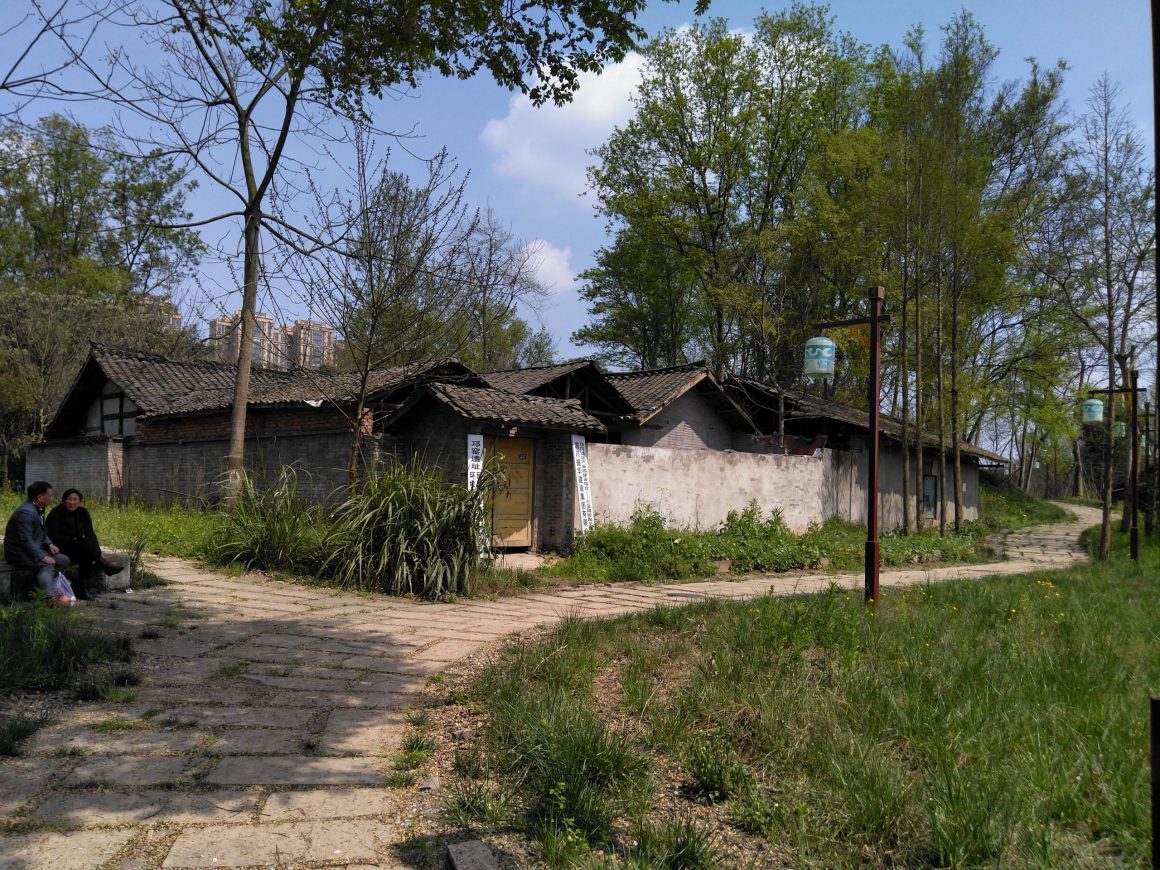
▽拆除危房后建筑基地和周边。After the demolition of the dangerous house, the construction base and surroundings.

▽挖基坑。Excavation of foundation pit.

实验室采用条形基础。基坑深度要挖到持力层。但实验室的选址在文物保护区,处于对文物保护的因素,实验室的基坑浅开挖,为加强结构稳定性,基础底面做大宽度混凝土条形柔性基础,减少沉降压强。
1. 选择条形基础或独立基础的原则就是,如果是柱承重,选独立基础;墙承重,选条形基础。
2. 乡村房屋可浅开挖,如浅开挖,基坑需加大宽度,做混凝土柔性垫层。
3. 即便是乡村建设,仍然需要画施工图。实验室项目因地基的特殊性,开挖后紧急修改过基础形式,没来得及做新的结构计算变施工,导致基础单项成本增加两万。钱一般的教训啊。
The laboratory uses a strip base. The depth of the pit should be dug into the holding layer. However, the location of the laboratory is in the cultural relics protection area, which is in the factor of cultural relics protection, the laboratory’s foundation pit is shallow excavation, in order to strengthen the structural stability, the foundation bottom surface is made of large width concrete strip flexible foundation, reducing the settlement pressure.
1. The principle of choosing a bar base or an independent foundation is that if it is a column load-bearing, choose an independent foundation; Wall load-bearing, choose a bar foundation.
2. Rural houses can be shallow excavation, such as shallow excavation, the foundation pit needs to be increased in width, and the concrete flexible cushion layer is made.
3. Even in rural construction, construction drawings still need to be drawn. Due to the particularity of the foundation, the laboratory project urgently modified the foundation form after excavation, and did not have time to do new structural calculation and construction, resulting in an increase of 20,000 yuan in the single cost of the foundation. Money-like lessons.
▽基础施工。foundation construction.

因实验室的主体结构为框型夯土,基础采用条形基础。底板筋采用18直径螺纹钢,纵向8根,横向间距250毫米(后经过结构计算证明过满)。
所有有墙的位置必设基础。条形基础因沿轴线贯通,或设拉结基础圈梁,提高整体性以抗震。
Because the main structure of the laboratory is a frame rammed earth, the foundation adopts a strip foundation. The bottom plate ribs are made of 18 diameter rebar, 8 longitudinal, and 250 mm lateral spacing (later proved to be too full after structural calculations).
All locations with walls must have a foundation. The strip foundation is connected along the axis, or the base ring beam is pulled to improve the integrity to resist earthquakes.
▽地圈梁浇筑完成后,开始夯一层墙体。After the pouring of the earth circle beams is completed, the ramming of a layer of the wall begins.

1. 混凝土圈梁浇筑完成后,需经过5天左右的养护才能在圈梁上开始夯土
2. 夯土墙抗震第一原则,一定要形成框筒结构,大框筒需中间加墙形成两个长宽比不大的框筒。
1.After the concrete ring beam is poured, it takes about 5 days of maintenance to start ramming the ring beam.
2. The first principle of rammed earth wall seismic resistance must form a frame structure, and the large frame tube needs to be added to the middle to form two frames with a small length-width ratio.
▽一层墙体夯完,支模浇筑圈梁和二层楼板。The first floor of the wall was rammed, and the support mold was poured with circle beams and two floor slabs.

因为实验室必须留出公共大空间,所以在大空间一侧无法形成框筒结构,只能改做片墙。片墙在纵向上抗震性能优异,但在锤子片墙方向抗震性能几乎为零。实验室项目采用在片墙的纵向预埋一根通长的高强度工字钢的工艺来解决这一问题。工字钢和混凝土楼板预埋件焊接,将混凝土楼板(水平各项抗震性能接近无穷大)、抗震半框连城整体,加强抗震性能。
1. 混凝土圈梁不仅起到加强水平抗震性能的作用,还成为夯土结构墙体和屋顶轻钢系统的承接系统发挥作用。钢的材料特性耐碱不耐酸,而混凝土是碱性的,夯土一般是酸性的。夯土和混凝土无缝承接,混凝土和钢无缝承接。
2. 预埋在夯土中的工字钢需做高强度防腐处理。预埋位置居中,采用小夯头夯机两侧打夯,否则工字钢在高强度的打夯中会发生位移。
Because the laboratory must leave a large public space, it is impossible to form a frame structure on the side of the large space, and can only be changed to a wall. The wall has excellent seismic resistance in the longitudinal direction, but has almost zero seismic resistance in the direction of the hammer wall. The laboratory project solved this problem using the process of embedding a longitudinal, high-strength I-beam in the longitudinal length of the sheet wall. I-beam and concrete floor slab embedded parts are welded to strengthen the seismic performance of concrete floor slabs (horizontal seismic performance is close to infinity) and seismic half-frame.
1.Concrete ring beams not only play a role in strengthening the horizontal seismic performance, but also play a role in the bearing system of rammed earth structural walls and roof light steel systems. The material properties of steel are alkali-resistant and not acid-resistant, while concrete is alkaline and rammed earth is generally acidic. Rammed earth and concrete are seamlessly undertaken, and concrete and steel are seamlessly undertaken.
2. I-beams buried in rammed earth need to be treated with high-strength anti-corrosion. The buried position is centered, and the two sides of the small rammer head rammer are used to rammer, otherwise the I-beam will be displaced in the high-strength ramming.
▽在楼板上夯第二层墙体,并搭建搭建钢结构楼梯。A second wall was rammed on the slab and a steel staircase was erected.

圈梁的上方立钢柱和主梁。四根主梁将片墙和抗震框筒在垂直方向上连成整体,片墙获得了两个方向上的抗震能力。
Above the ring beams are vertical steel columns and main beams. The four main beams connect the sheet wall and the seismic frame in the vertical direction, and the sheet wall obtains the seismic resistance in both directions.
▽搭接轻钢架系统和边廊系统。Lap light steel frame system and side gallery system.

边廊系统采用合造社研发的特殊构造断桥钢柱。钢柱既是承重构件,也可以做窗框使用。断桥钢柱间直接卡装中空保温玻璃。边廊屋顶结构采用工字钢作梁,下翼缘安装波纹板,形成盆型空间可填充保温材料。
1.轻钢屋架的结构形式一般有框架结构和品架结构两种形式。其区别在于,框架结构在两个水平方向均可受力,品架结构只能承受平行于品架结构的力。框架结构有更好的整体性能,但造价略高于品架结构。实验室采用框架结构是为了加强房屋的抗震性能。
2. 玻璃廊的金属构件,必须采用断桥构造。否则,除了浪费空调运行费用,更严重的是会烫伤人。
The side corridor system uses a special structure of broken bridge steel columns developed by Hezhuang Society. The steel column is both a load-bearing member and can also be used as a window frame. Hollow insulating glass is directly attached between the steel columns of the broken bridge. The roof structure of the side corridor adopts I-beam steel, and the lower flange is equipped with corrugated plates to form a basin-shaped space that can be filled with insulation.
1. The structural form of light steel roof truss generally has two forms: frame structure and shelf structure. The difference is that the frame structure can be subjected to force in both horizontal directions, and the shelf structure can only withstand the force parallel to the shelf structure. The frame structure has better overall performance, but the cost is slightly higher than the shelf structure. The laboratory adopted a frame structure to enhance the seismic performance of the house.
2. The metal components of the glass gallery must be constructed of a broken bridge. Otherwise, in addition to wasting the operating costs of air conditioning, it will burn people more seriously.
▽安装边廊屋顶,檩条同时可以施工地面。Install the roof of the side porch, and the purlin can also be used to construct the ground.

开始施工地面,就意味着离建成不远了。乡村地区潮气远大于城市地区。就算不做中央空调系统,也建议地面一定要做防潮保温层。如果考虑中央空调或供暖,防潮保温地面构造接近10层,构造厚度接近180毫米。据我们的观察,目前在乡村地区的民宿,地面构造合理的寥寥无几。不少民宿,在打底垫层上直接铺青石板做面层,晚上房间内潮气远远高于室外可通风的地方,居住体感太差。如果不做中央空调,也希望少做构造节省建造费用,那么最好的构造方式就是在乡村地区使用了千百年的方式:三合土夯实。如果选择做现代工艺的地面,强烈建议采用防潮保温地面。
The start of construction of the ground means that it is not far from completion. Rural areas are much more humid than urban areas. Even if you don’t do a central air conditioning system, it is recommended that the ground must be made of moisture-proof insulation layer. If central air conditioning or heating is considered, the moisture-proof insulation ground structure is close to 10 layers, and the thickness of the structure is close to 180 mm. According to our observation, there are very few homestays in rural areas that have reasonable ground structure. Many homestays, in the base layer directly paved bluestone slabs as a surface layer, at night the room moisture is much higher than the outdoor ventilation place, living body feeling is too poor. If you don’t do central air conditioning, and you also want to do less construction to save construction costs, then the best way to construct is the way used for thousands of years in rural areas: triad soil compaction. If you choose to do modern technology on the ground, it is highly recommended to use moisture-proof insulation floor.
▽封玻璃,封门窗,做隔墙,做维护。Seal glass, seal doors and windows, do partition walls, do maintenance.

如果考虑做中央空调,门窗一定要用可密闭的断桥中空玻璃门窗。一般来说,对于像实验室这样的有大面积玻璃面或者大面积开门窗的建筑来说,使用中央空调的单月能耗费用,做了密闭断桥中空玻璃维护的建筑约为600元/百平,不做约为1500元/百平。
If you consider doing central air conditioning, doors and windows must use insulating glass doors and windows that can be sealed with broken bridges. Generally speaking, for buildings with large-area glass surfaces or large-area doors and windows like laboratories, the monthly energy consumption cost of using central air conditioning is about 600 yuan / 100 square meters for buildings that have been maintained by insulating glass of closed broken bridges, and about 1500 yuan / 100 square meters.
▽安装铝镁锰金属夹芯保温板屋面,厚度120。Install aluminum magnesium manganese metal sandwich insulation board roof, thickness 120.

关于“如何在乡村给自己建座房子?”的其他知识点 On “How do you build yourself a house in the countryside?” Other knowledge points
1. 关于造价。在乡村建房子便宜是一个设置了条件的事实,也是一个被广泛曲解的谣言。关于造价的正确理解应该是:在乡村建房子可以便宜,也可以很贵。首先,大家对于造价便宜的意向是因为看到很多村民建房的单方造价很低。但这个底价是有条件设置的。村民建房计算的造价大多只是材料价格,而人工成本则在乡村的那种特殊社会结构里被化解了,一家建房,一村帮忙。其次,在乡村建房,造价高低直接来自其功能所需要的设备等级。如,是否安装中央空调所带来的造价差别。造价的增加并不仅仅是设备购买和安装费用,更重要的是因为匹配这些设备所需要的构造措施。就像前文所提到的,如果不安装空调,地面最好的构造方式就是一层夯实的三合土,但安装空调,地面的构造层可以达到十层,相应的屋面,玻璃门窗等,这其中的造价差别可以达到三到四倍。所以关键不在于是在哪里建房,而在于所需功能以及它所匹配的建造方法。
2. 关于如何节省成本。在我们的乡建实践中,会看到可喜的观念变化。从以前觉得设计没有价值到现在大部分人愿意支付设计费。但我们也看到一个普遍的错误观念,很多人认为设计有价值(因为颜值经济的时代到了),于是拿着设计方案文本就开始施工(因为乡村建造目前还不需要报建审图,也因为要节省施工图设计费用)。但素不知,方案负责颜值,施工图既保证颜值落实,也(更重要的是)负责靠谱省造价,也(最重要的是)保证房屋安全。以建筑/艺术创新实验室的这个项目为例,因为基础修改时间太紧,没有做合理的结构计算,就多出两万的造价。而一份优秀的施工图能从结构、水电、设备各个方面协调统筹,缩短建造工期,节省建造成本。同时,正因为乡村建设目前还无需报建审图,施工图环节就成了保证安全的唯一依据。我们曾经在一个乡建现场,看到一处七米高的砖砌单层房屋,没有设任何构造圈梁,四角的构造柱主钢筋是四根直径6mm的圆钢,箍筋居然是铁丝!心惊胆战!
1.About the cost. The fact that building a house in the countryside is cheap is a conditional fact and a widely misinterpreted rumor. The correct understanding of the cost should be: building a house in the countryside can be cheap or expensive. First of all, everyone’s intention to build a cheaper cost is because we see that many villagers have a very low unilateral cost of building houses. But this reserve price is set conditionally. Most of the cost calculated by villagers to build houses is only the price of materials, while labor costs are dissolved in the special social structure of the countryside, one family building a house, one village helping. Secondly, in the countryside to build a house, the cost of the level directly comes from the level of equipment required for its function. For example, the difference in cost caused by whether to install central air conditioning. The increase in cost is not only the cost of equipment purchase and installation, but more importantly, the construction measures required to match these equipment. As mentioned earlier, if air conditioning is not installed, the best way to construct the ground is a layer of compacted triad, but the installation of air conditioning, the structural layer of the ground can reach ten floors, the corresponding roof, glass doors and windows, etc., the cost difference can reach three to four times. So the key is not where to build the house, but the required features and the construction method it matches.
2. On how to save costs. In our rural construction practice, we will see gratifying changes in concepts. From the time when design was not valuable, most people are now willing to pay design fees. But we also see a common misconception that many people think that design is valuable (because the era of the value economy has arrived), so they start construction with the design plan text (because rural construction does not need to apply for construction review, but also because it is necessary to save the cost of construction drawing design). But I don’t know that the plan is responsible for the appearance, the construction drawings not only ensure the implementation of the appearance, but also (more importantly) responsible for reliable cost savings, but also (most importantly) to ensure the safety of the house. Take the architecture/art innovation lab project as an example, because the foundation modification time is too tight, without reasonable structural calculations, it will cost 20,000 yuan more. An excellent construction drawing can coordinate from all aspects of structure, water and electricity, and equipment, shorten the construction period, and save construction costs. At the same time, precisely because rural construction does not need to submit construction drawings for review, the construction drawing link has become the only basis for ensuring safety. We once saw a seven-meter-high brick single-storey house at a rural construction site, without any structural ring beams, the main steel bar of the four corners of the structural column is four round steel with a diameter of 6mm, and the stirrups are actually wire! Chill!
建筑关键词 KEYWORD
“建筑/艺术创新实验室”修建在邛窑遗址公园,一处国家级的遗址中。从汉代开始,这个地方便聚集了大批能工巧匠从事制陶,直至清代末期。历史在现场留下了十四个窑包,窑包上长满了参天的大树,时不时能在树林中发现沉睡上千年的陶瓷碎片,证明智力和劳动的镌刻。由于邛窑是民间窑址,在历史的发展中,制陶又和农耕行为紧紧的联系在一起,所以在空间上,形成及其特殊的地貌形态:散布的窑包穿插着川西农耕的林盘布局——生产-生活-农耕的三位一体,社会结构和空间地貌交相辉映。“建筑与艺术创新实验室”的选址,便是这十多个林盘小院中的一处。
它来自历史,在这一刻被注入新的时代含义。
The ” INNOVATIVE LAB of ARCHITECTURE & ART ” was built in Qiongyao Relic Park, a national relic site. From the Han Dynasty, thousands skilled craftsmen gathered here making pottery until the end of the Qing Dynasty. Fourteen kiln sites left behind the history, covered with towering trees, among which people found ceramic fragments of thousand years, proving the engravings of intelligence and labor. Since Qiongyao was a folk kiln, pottery and farming were closely linked in the history of development, shaping special form of geomorphology: the kiln sites were scattered and inserted in the layout of the farm and yards – the trinity of production – Life – farming. The social structure and the spatial geomorphology enhanced each other’s being. One of those yards, now, became the site of the INNOVATIVE LAB of ARCHITECTURE & ART.
It came from history and now will be injected with new concepts at this moment.
▽遗址公园 location in the relic park
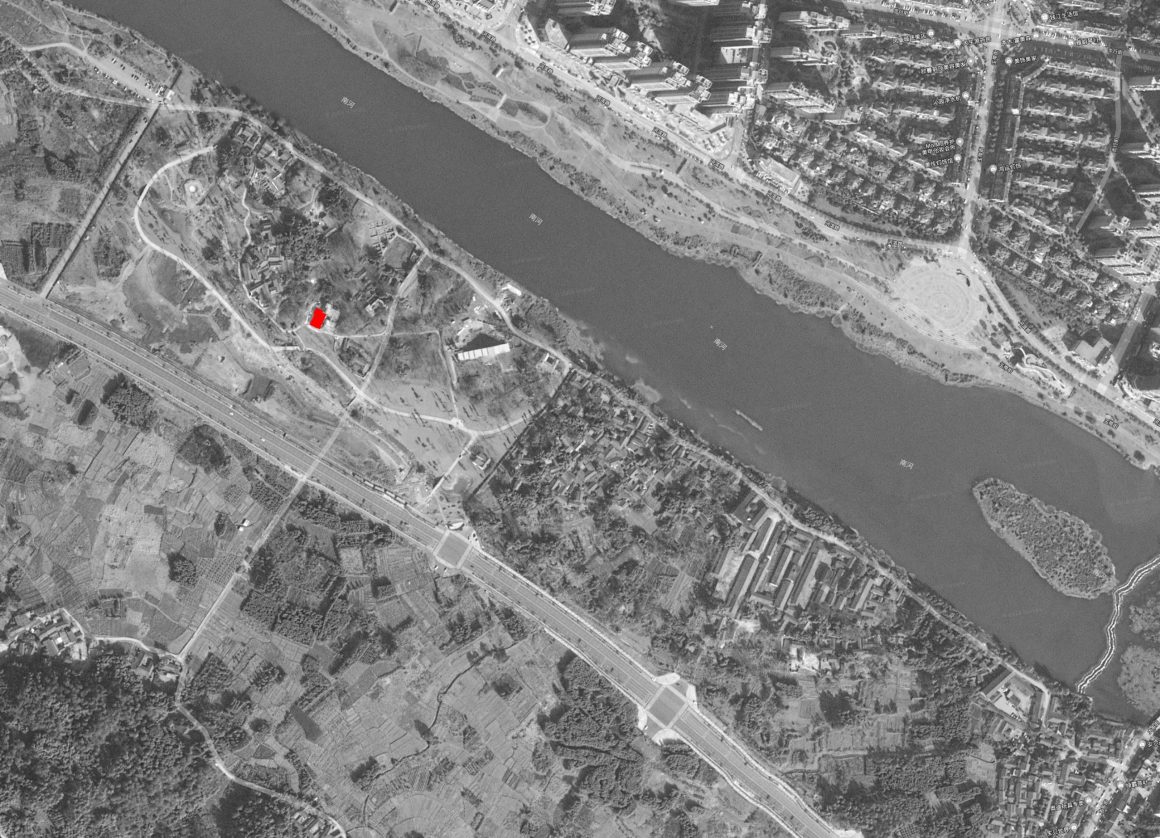
▽设计模型对遗址中建筑的想象。Design modeling: an imagination to the building in relics
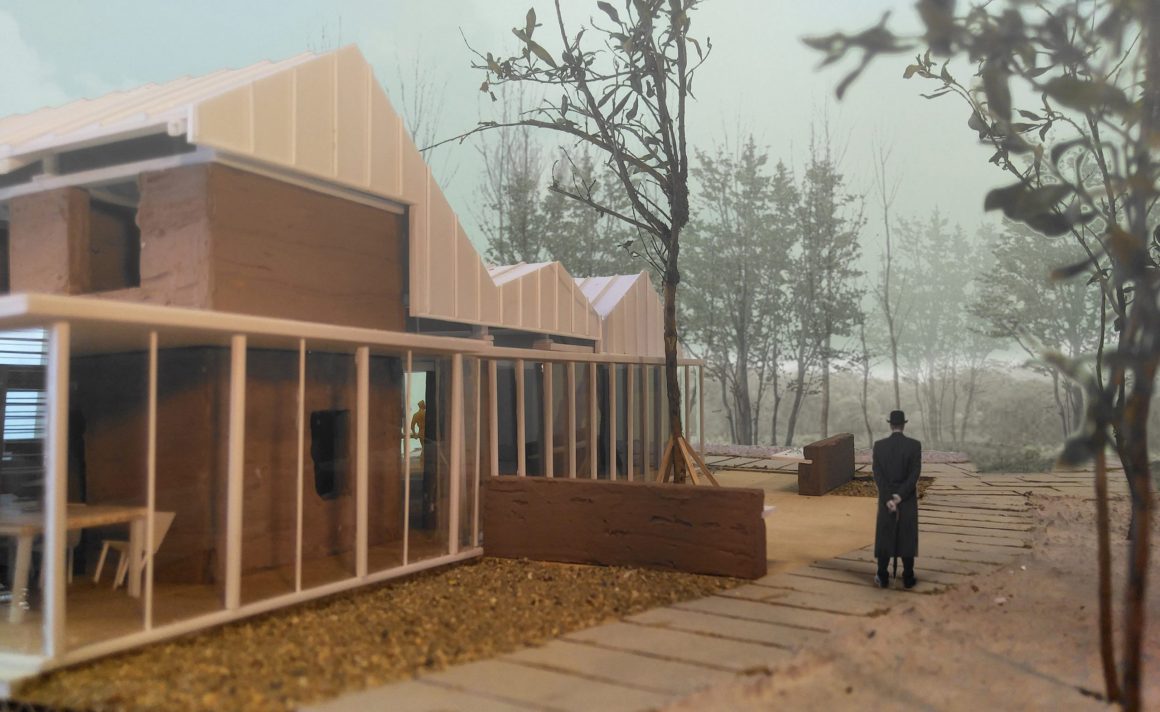
夯土:作为社会关系的载体 Rammed Earth:as social relation
“建筑/艺术创新实验室”将采用同样在历史中发展,却开始沉睡的技艺:夯土。同样,这个项目希望通过它自身的建造实验,赋予这项技艺时代含义。例如它可以用于抗震八度设防区;可以再次作为空间的结构体系而不仅仅是一种视觉的装饰;可以在它的生命周期结束之后重新降解入土地,而不是成为建筑垃圾;通过手工建造因而可以继续在乡村的“前现代”现实中流传,而不是将它从乡村生活中抽离。因此,时代含义,既是这个时代的技术上的含义,也是这个时代的社会关系的含义。
“INNOVATIVE LAB of ARCHITECTURE & ART”will employ a technique that has also developed in history but has begun to sleep: rammed earth. Again, the project hopes to give meaning to the art of the art through its own experiments of construction. For example, it can be used for seismic octave fortification areas; Can again be used as a structural system of space and not just a visual decoration; It can be re-degraded into the land after its end of life, rather than becoming construction waste; By hand construction it is thus possible to continue to circulate in the “pre-modern” reality of the countryside, rather than withdrawing it from rural life. Therefore, the meaning of the era is both the technical meaning of this era and the meaning of the social relations of this era.
▽夯土墙Rammed earth wall
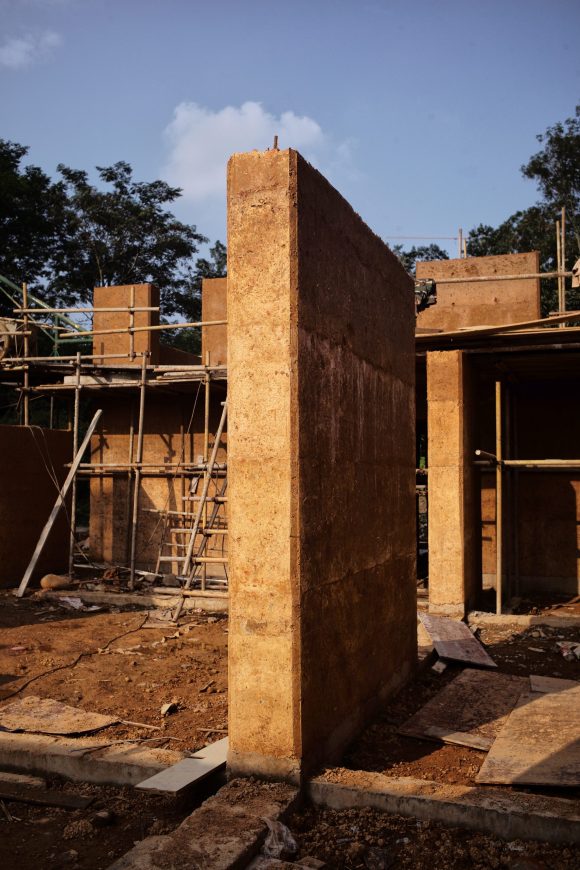

前现代乡村和现代体感: 结构级断桥幕墙 & 集成防水保温屋面
A Modern Sense with the Pre-Modern Reality: Structural Broken Bridge & Integrated Roof
▽施工中的实验室公共空间 Laboratory public space under construction

建筑安装了中央空调和热水循环系统,赋予建筑现代体感。建筑维护体系的构造等级需匹配设备。考虑到乡村建造的现实,重新设计了断桥幕墙和保温防水的集成屋面。结构级断桥幕墙:幕墙采用钢框架,断桥设置在结构层级上。每一根钢柱均由两根型钢组成,型钢间隙填充绝热材料。中空玻璃作为维护系统直接安装在断桥型钢的卡槽里。室外和室内 完全隔绝。型钢尺寸减小,手工定位和焊接成为可能。立面获得均值等宽的视觉。
保温防水集成屋面:选择纳米板作为型材,将岩棉保温层和防 水层集成压制,工厂生产后安装于结构檩条上。这种集成屋面是相同热工性能的市场产品造价的 1/3。
Central air conditioning and hot water circulation system are installed in the building, which gives the building a modern sense. The construction grade of maintenance system needs matching equipment. Considering the reality of rural construction, I redesigned the curtain wall of broken bridge and the roof integrated with insulation and waterproof. Curtain wall of structural broken bridge: Curtain wall adopts steel frame, and broken bridge is set at structural level. Each steel column consists of two profiles filled with insulation material. Hollow glass as a maintenance system is directly installed. Outdoor and indoor are completely isolated. With the reduction of section size, manual welding are possible. The facade obtains a vision of equal width.
Insulation and waterproof integrated roof: nano-plate is selected as profile material, rock wool insulation layer and waterproof layer are integrated pressed, and installed on purlin after factory production. This kind of integrated roof is one third of the cost of market products with the same thermal performance.
▽结构级断桥 Structural level broken bridge
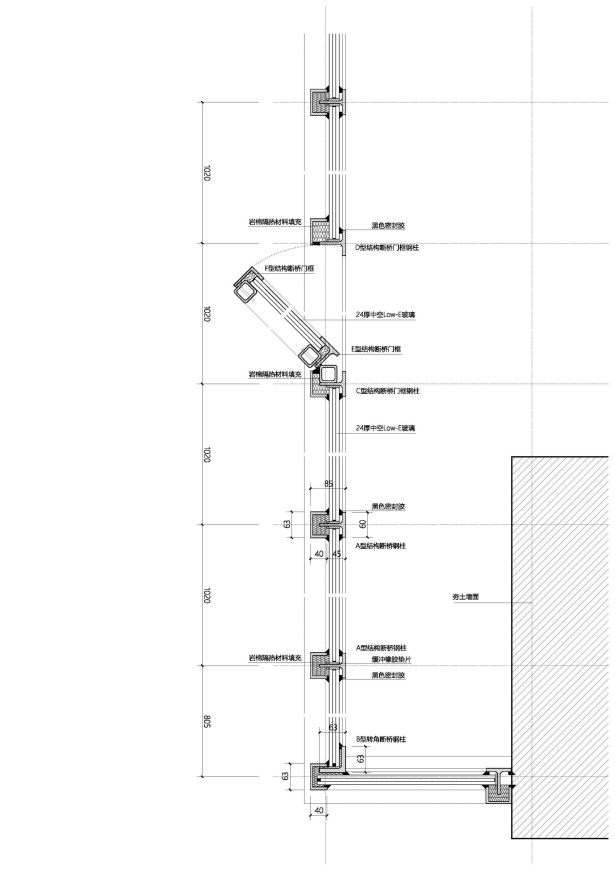
照明:作为一种结构形式 Lighting: as a Form of Structure
这个建筑的建造逻辑清晰到具有排他性,以至于在建筑建造结 束后找不到安装灯具的合适位置。于是,我们用制造结构的方式构造了一 个灯光的空间装置。所有杆件只受拉或者受压,在这些结构杆件上安装上 半透明亚克力管和线性的光源。光对空间进行了三维的切割。
艺术家李宏红参与了这组装置的设计和建造,并提供了技术支持。
Frankly, the building’s construction logic is so clear and exclusive that it can’t find the right place to install lights after construction completed. Therefore, we create a lighting installation by means of manufacturing structure. All member bars are merely tensioned or compressed, and semi-transparent acrylic tubes are installed on these structural members with linear light sources. Light cuts the space in three dimensions.
Artist Li Honghong was involved in the design and construction of the installation and provided technical support.
▽灯光装置 Lighting device
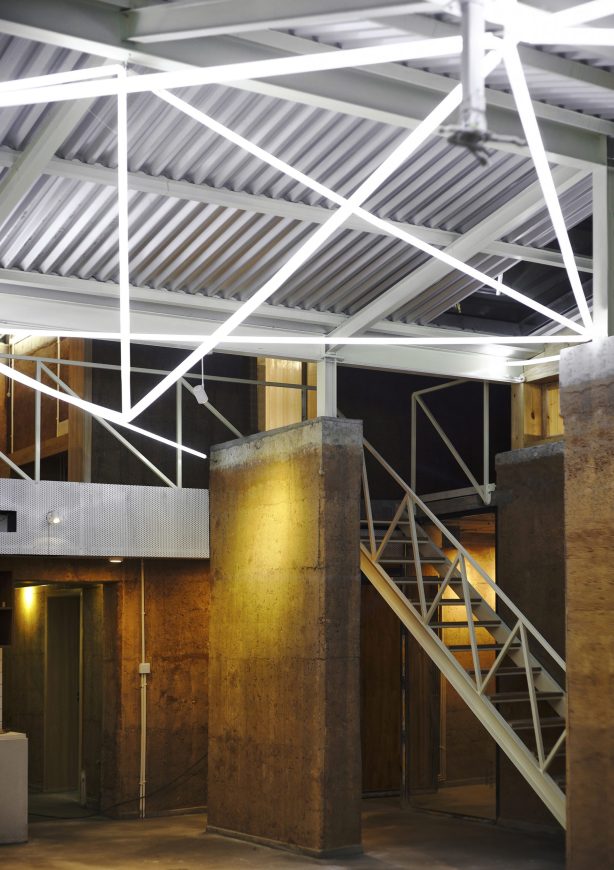
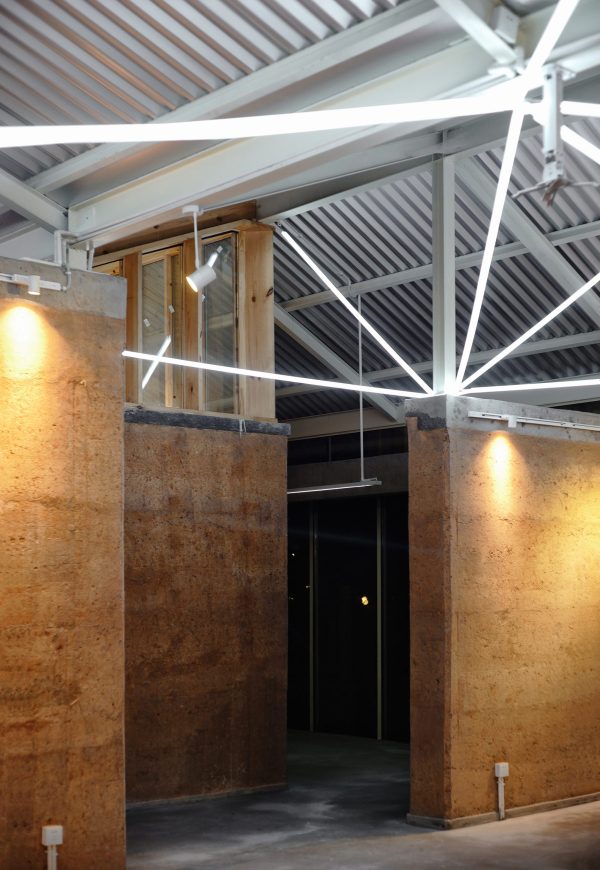
实验的空间运营 Space Operation as Experiment
整个建筑的空间包含一处用于公共活动沙龙的概念茶室,建筑师与艺术家的驻留空间,以及工作室。空间由几个夯土的筒体或半筒体结构搭建而成。筒体中是相对私密性的驻留居住空间,而筒体之间或筒体的外部空间便是流动的公共区域。常驻和驻留的艺术家或建筑师的工作,便是这个空间能提供给公众的风景,这也许是对形成这一遗址公园的原因——长达千年的匠人智力、劳动、和创造——最好的回应和继承。作为公共空间的概念茶室,试图实践能扎根于乡村的新型农业。合造社和农创人一起合作,经营这个概念茶室,也希望能赋予中国传统的茶饮新的体验和意义。
The whole building includes a conceptual teahouse for public activities salon, the residence of architects and artists, and CLAB’s studio. The space is made up of several rammed earth’s cylinder and half cylinder structure. The cylinders itself are residence spaces as they are relatively private, and the between those cylinders is the flowing public area and studios. The work scene of artists or architects is a landscape that the space can provide to the public, which may be the best response and inheritance to the intellect, labor, and creation of a thousand years of craftsmen. As the main public space, a conceptual teahouse tries to practice new agriculture that can be rooted in the rural area. Architects of CLAB cooperate with a creative agriculture people who has been engaging in tea making, working together to run the concept teahouse, hoping to give new experience and meaning to Chinese traditional tea drinking.
▽驻留空间 Resident space
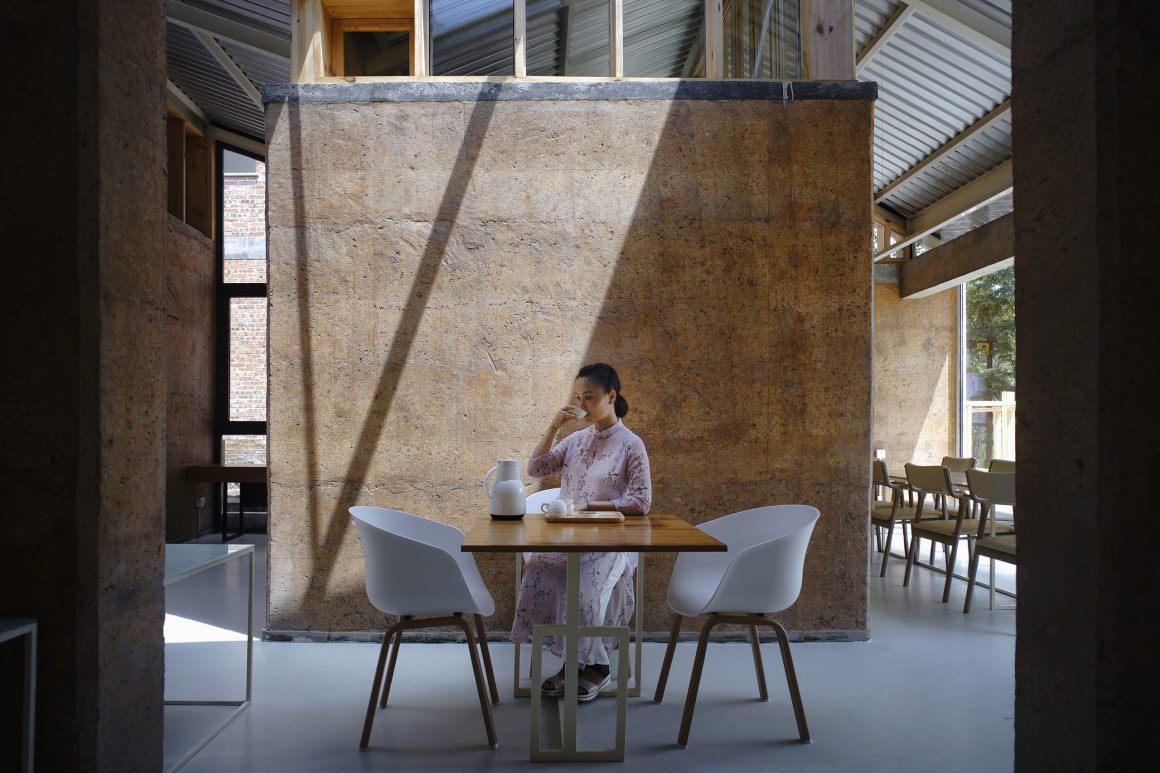
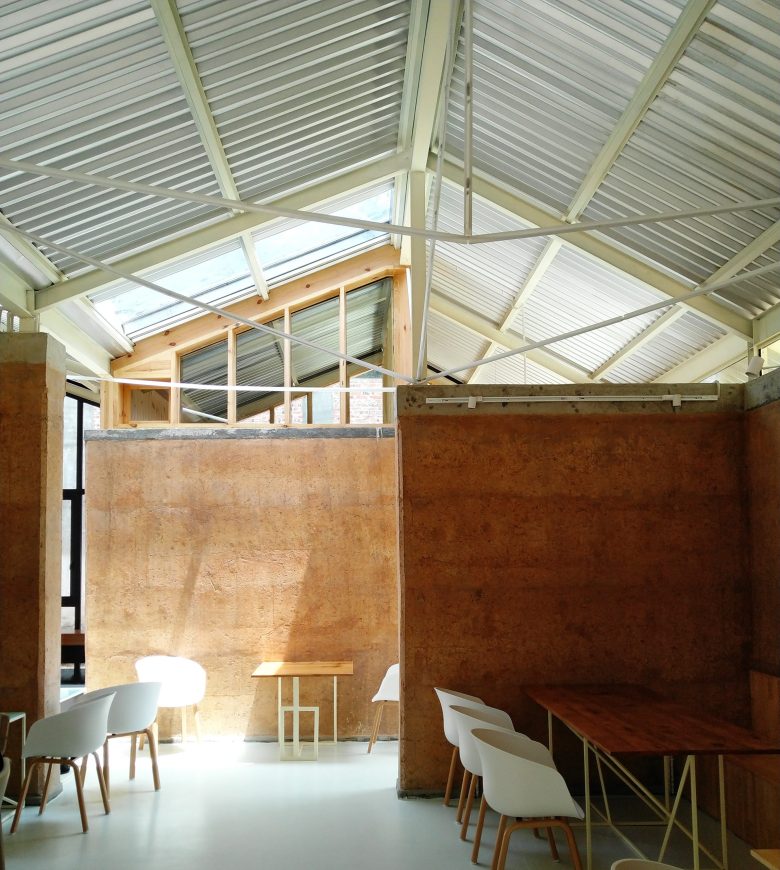
新遗址 a New Relic
建筑外修筑起了两片夯土的矮墙,在矮墙的半腰处是一片混凝土的桌面,它保护着矮墙的墙根不受雨水的侵蚀。而矮墙的另一面,将暴露在自然的阳光和雨水之中。土墙会随着时间的推移降解,慢慢回归大地,这一过程也许将长达几十年。构成了一处现代的遗址。
公园里树木参天,那里的一切都来自历史,也将进入历史。
Outside the building are two rammed earth parapets. At the waist of the parapet is a concrete desk, which protects the foundation of the parapets from rain. The other side of the parapet will be exposed to natural sunlight and rain. The earth parapet will slowly decay over time and return to the earth.
This process may last for decades: a modern relic is made up.
Trees in the park are over the sky, where everything is from history and will enter history.

建筑图片 PICTURES


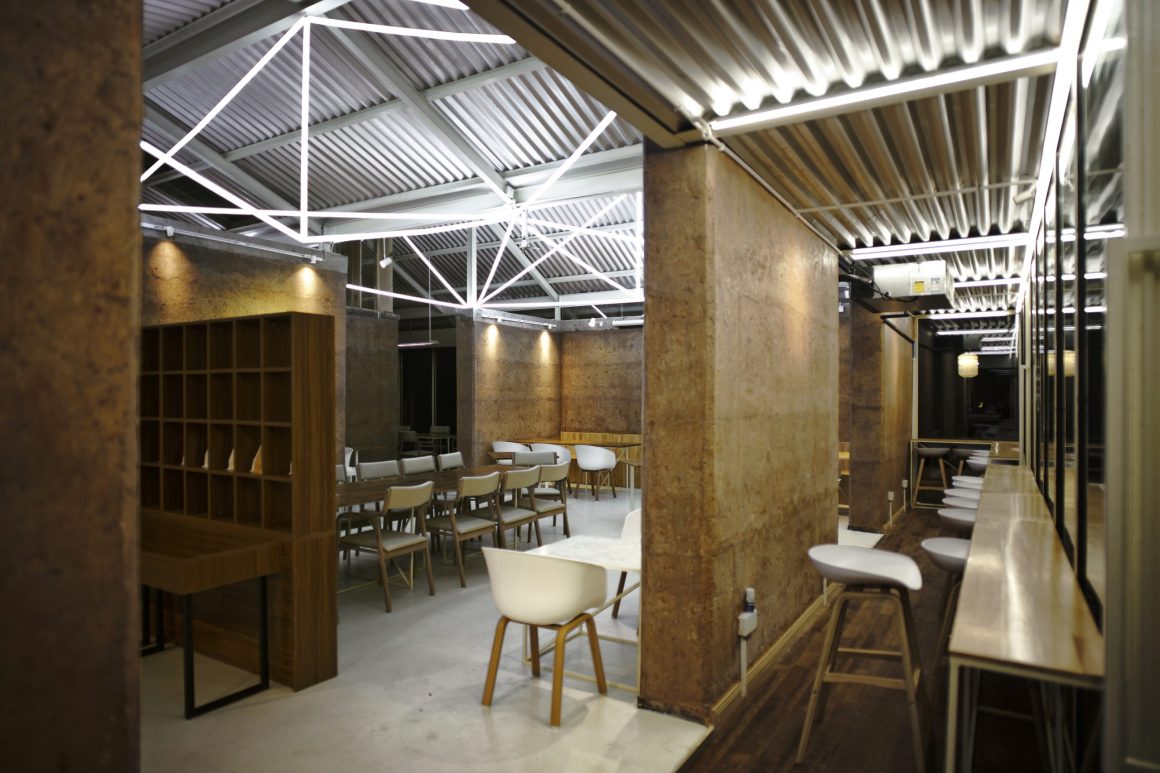
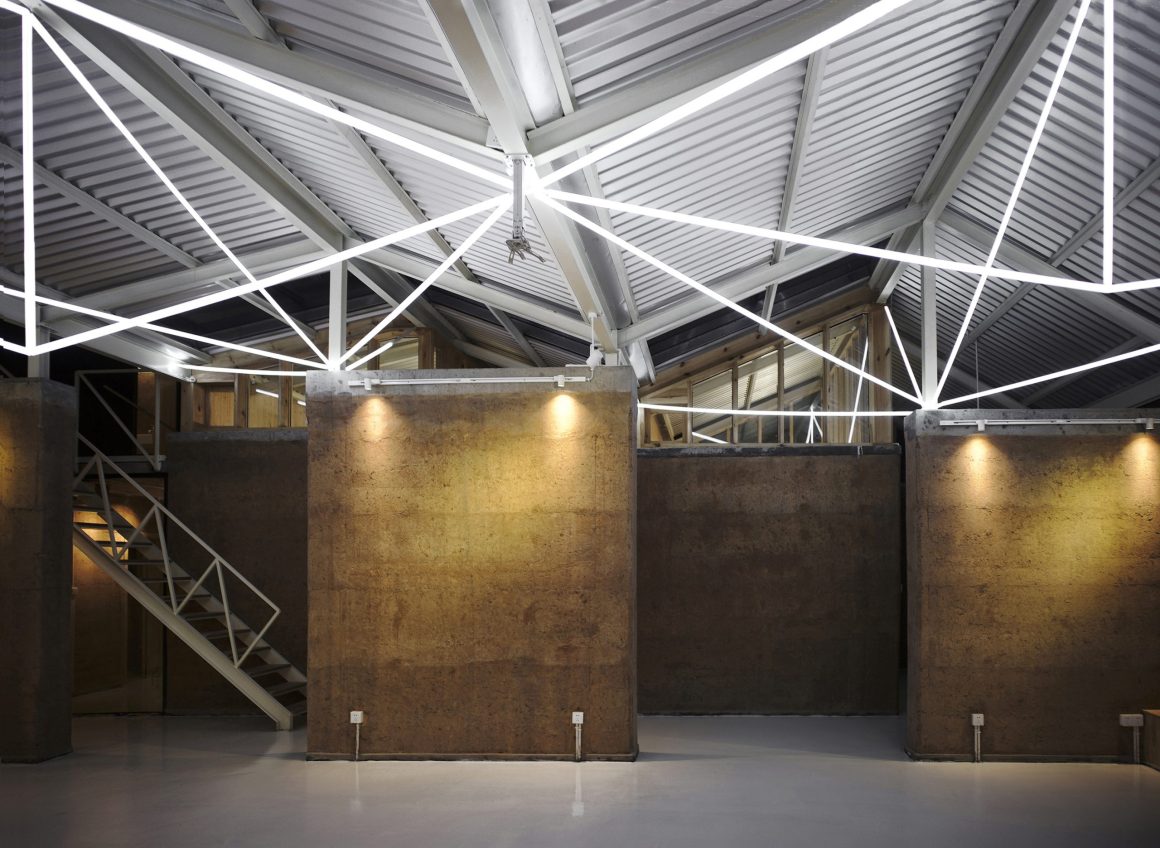
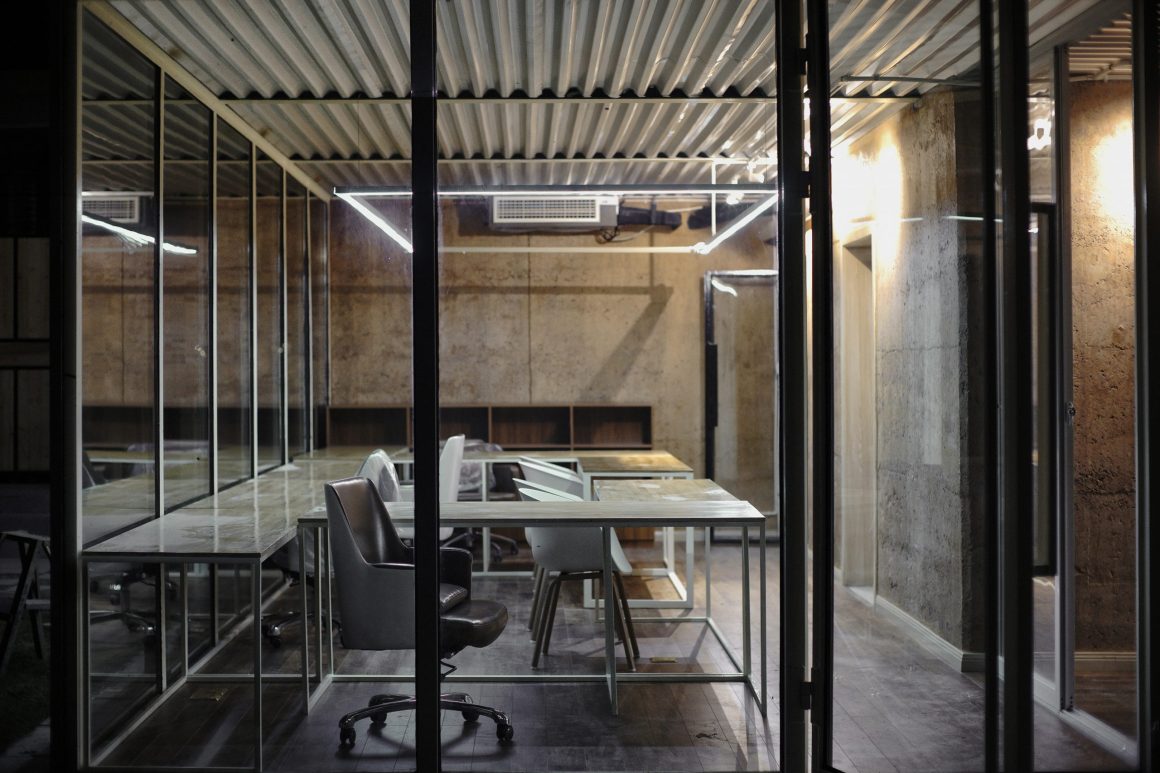
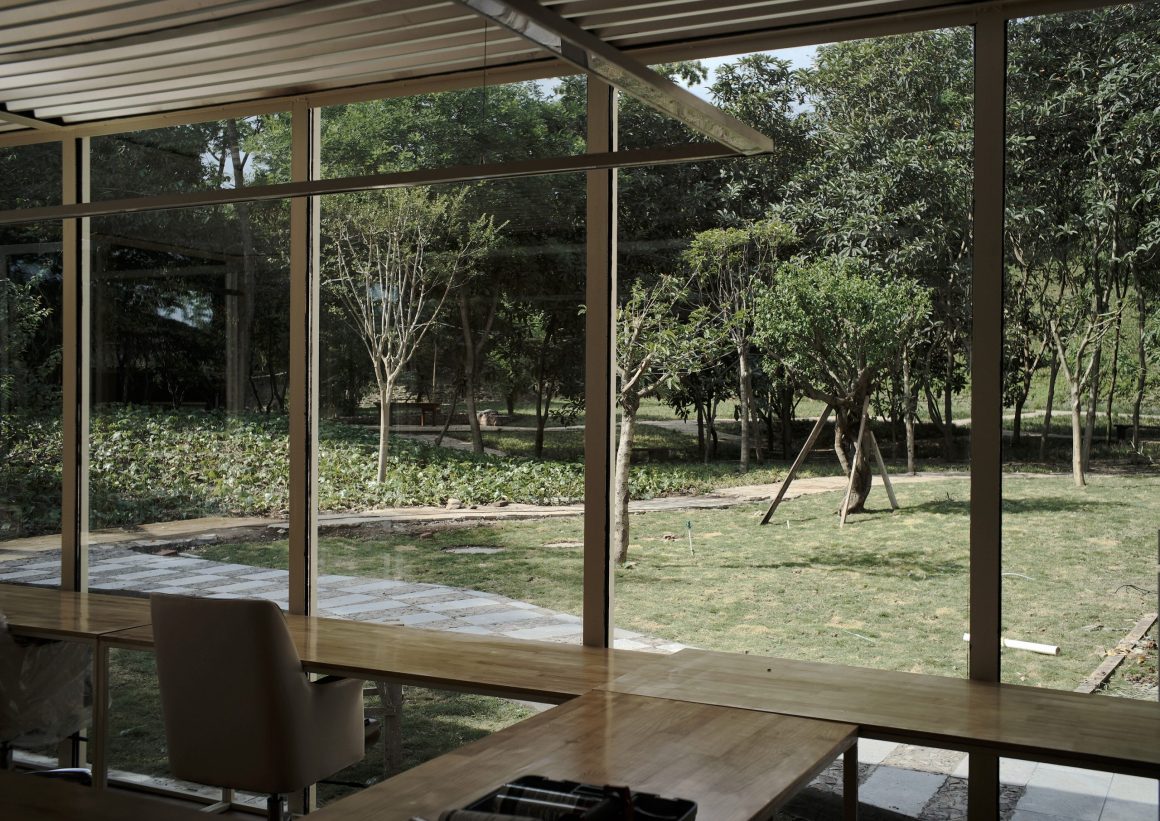
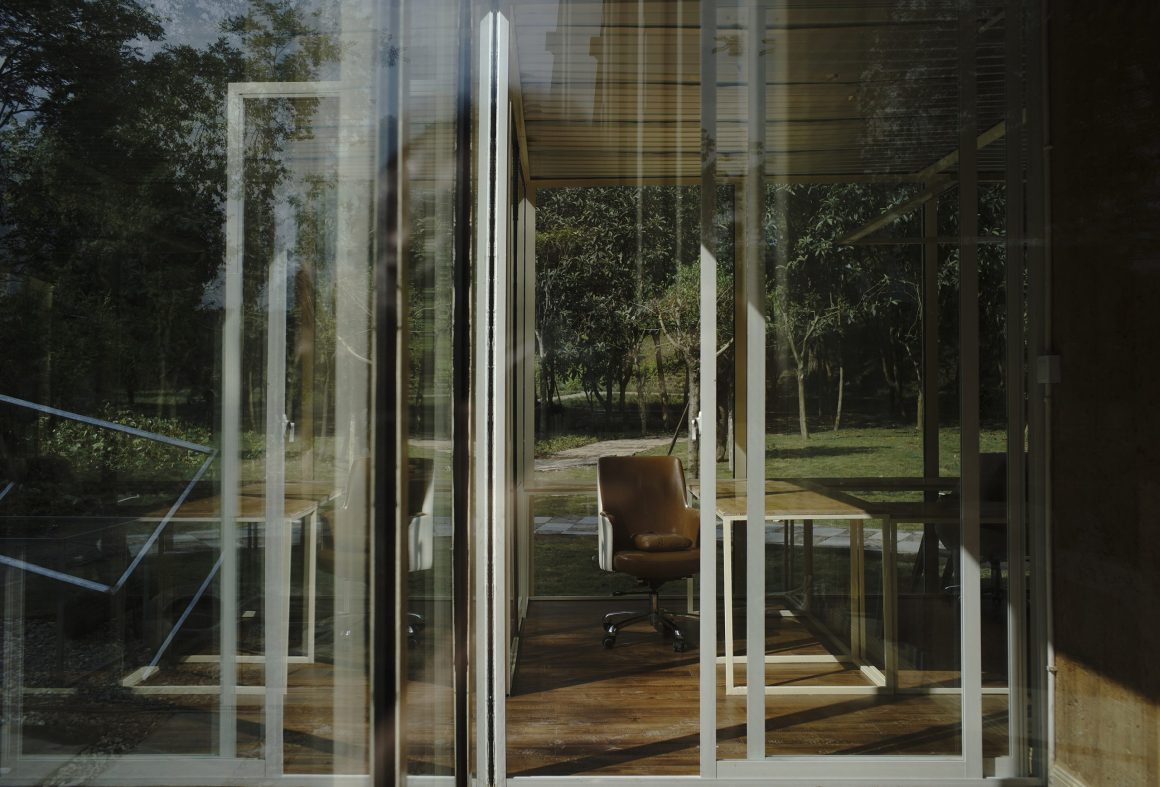
▽合造社邛崃工作室以及对面的窑包 The Qionglai Studio of the Hezo Society and the kiln bags on the opposite side
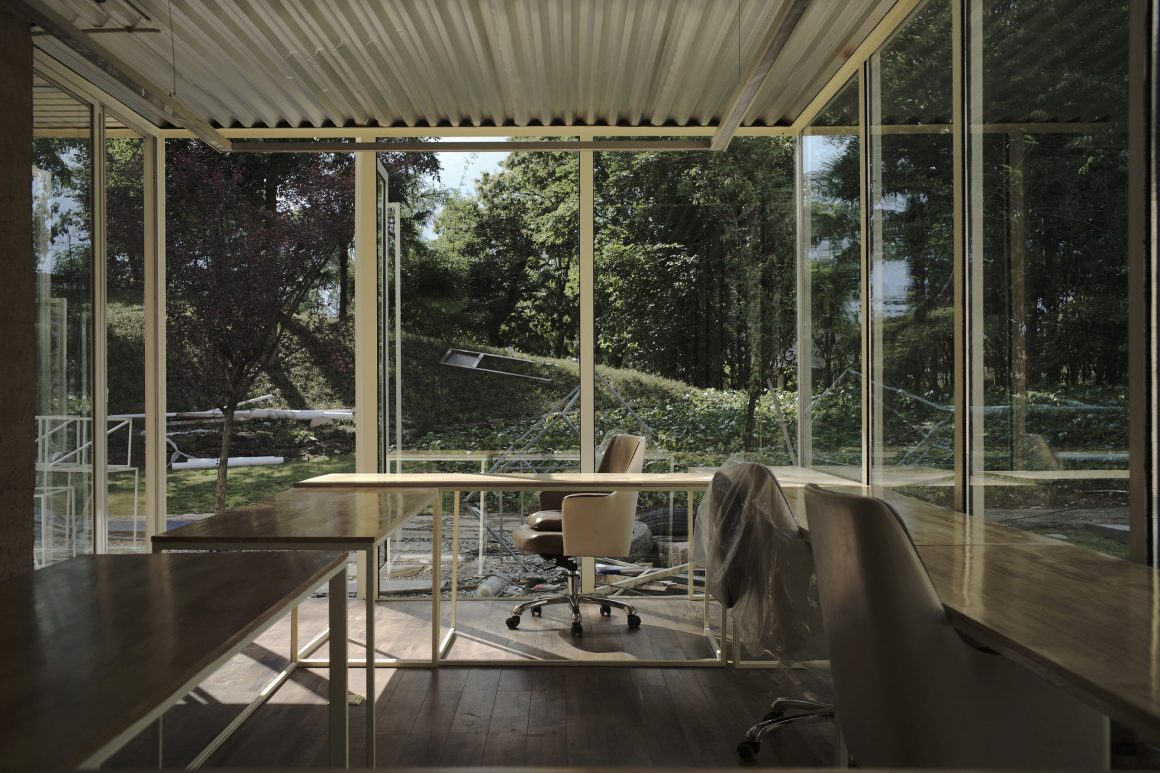
▽建造中,建筑师谢英俊在工地中分享了他的乡建实践讲座 During the construction, architect Xie Yingjun shared his lecture on rural construction practice at the construction site

屋面 the material of roof
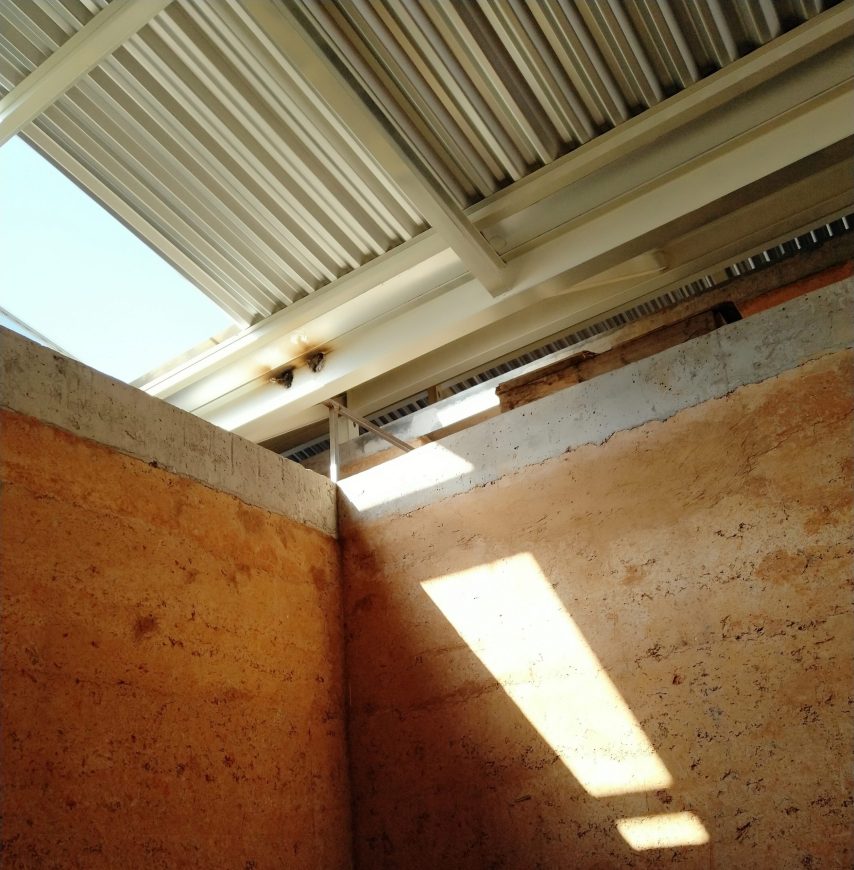
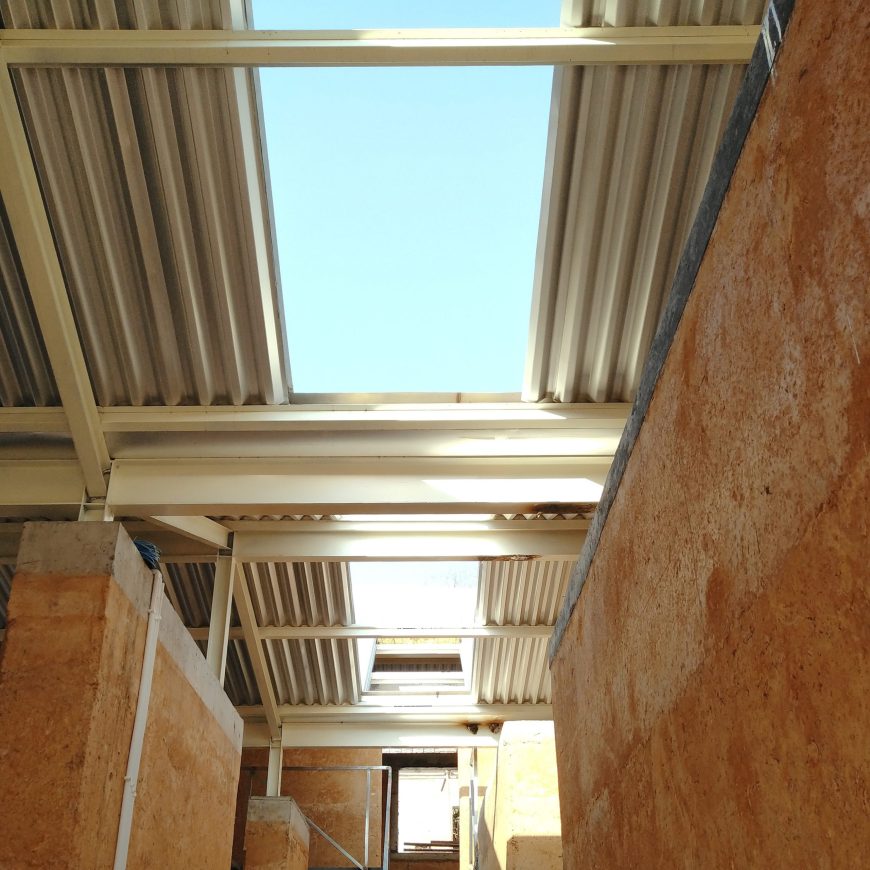
项目名称:建筑/艺术创新实验室
建筑设计:合造社建筑设计事务所
微信公众号:合造社CLAB
项目合作邮箱联系:281726654 @qq.com
媒体咨询邮箱联系:xilliyzhao@163.com
微信助手:CLAB2017
设计时间:2017.04-2017.09
建成时间:2018.05
建筑面积:建筑305㎡
项目地点:中国,成都,邛崃,邛窑遗址公园
Google map 定位:http://www.google.cn/maps/@30.3975999,103.4471107,57m/data=!3m1!1e3
主创建筑师:徐浪
设计团队:徐浪,陈东旭,王贺(合造社)
夯土技术:万丽/迟辛安(香港中文大学)
结构计算:冉晋滔
模型制作:武昊,杨静超
装置艺术家:李宏红
施工经理:徐刚
投资人:合造社+无由茶室
摄影版权:合造社
项目类型:乡村建筑
材料:夯土、钢、混凝土
Project Name:INNOVATIVE LAB of ARCHITECTURE & ART
Architects: CLAB
WeChat Official Account: 合造社CLAB
Project Contact e-mail: 281726654 @qq.com
Media Contact e-mail: xilliyzhao@163.com
WeChat:CLAB2017
Design: 2017.04-2017.09
Project Year: 2018.05
Area: 305㎡
Location:Qiongyao Relic Park, Chengdu City, Sichuan province, China
Google map:http://www.google.cn/maps/@30.3975999,103.4471107,57m/data=!3m1!1e3
Architects in Charge: XU Lang
Design Team: XU Lang, CHEN Dongxu, WANG He (CLAB).
Rammed Earth Technical Support:WAN Li / CHI Xinan (The Chinese University of HongKong)
Architectural Structure: RAN Jintao
Architecture Modelling: WU Hao, YANG Jingchao
Installation artist:LI Honghong
Construction Manager: XU Gang
Investor: CLAB + Wuyou Conceptual Teahouse
Photo Credits: CLAB
Program: Conuntry Architecture
Building materia:Rammed earth、steel、concrete
“ 这是一个使用传统的材料来建造的现代实验空间。”
审稿编辑 Maggie
更多 Read more about: 合造社建筑设计事务所




0 Comments